Samsung Electronics Co ML3710DW Laser Printer User Manual magpie basic english
Samsung Electronics Co Ltd Laser Printer magpie basic english
Contents
- 1. Users Manual 1
- 2. Users Manual 2
- 3. Users Manual 3
Users Manual 2
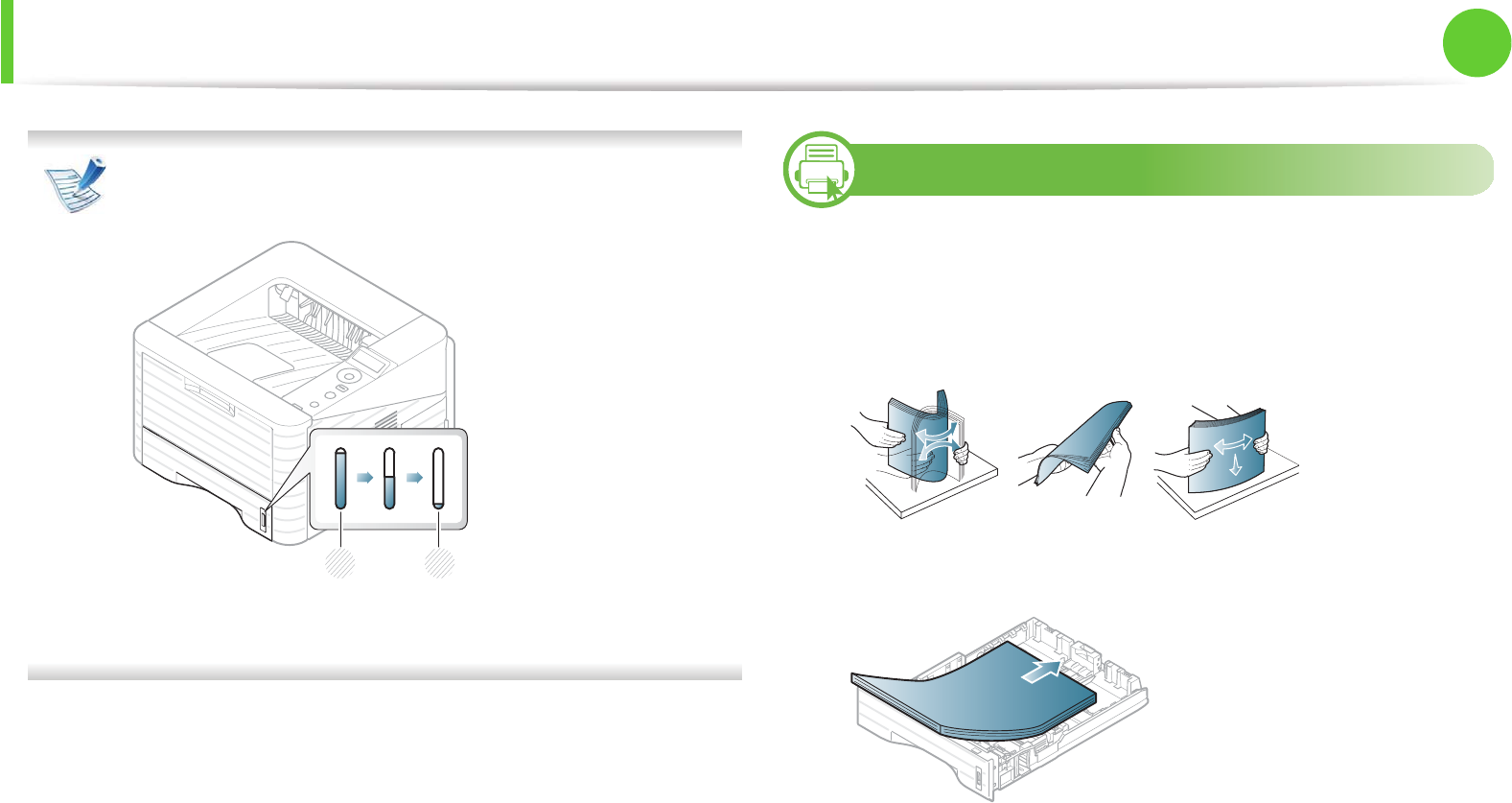
Media and tray 31
2. Menu overview and basic setup
Paper quantity indicator shows the amount of paper in the
tray.
1 Full
2 Empty
2
Loading paper in the tray/ optional tray
1Pull out the paper tray (see "Tray overview" on page 30).
2 Flex or fan the edge of the paper stack to separate the pages
before loading papers.
3 Place paper with the side you want to print on facing down.
1 2
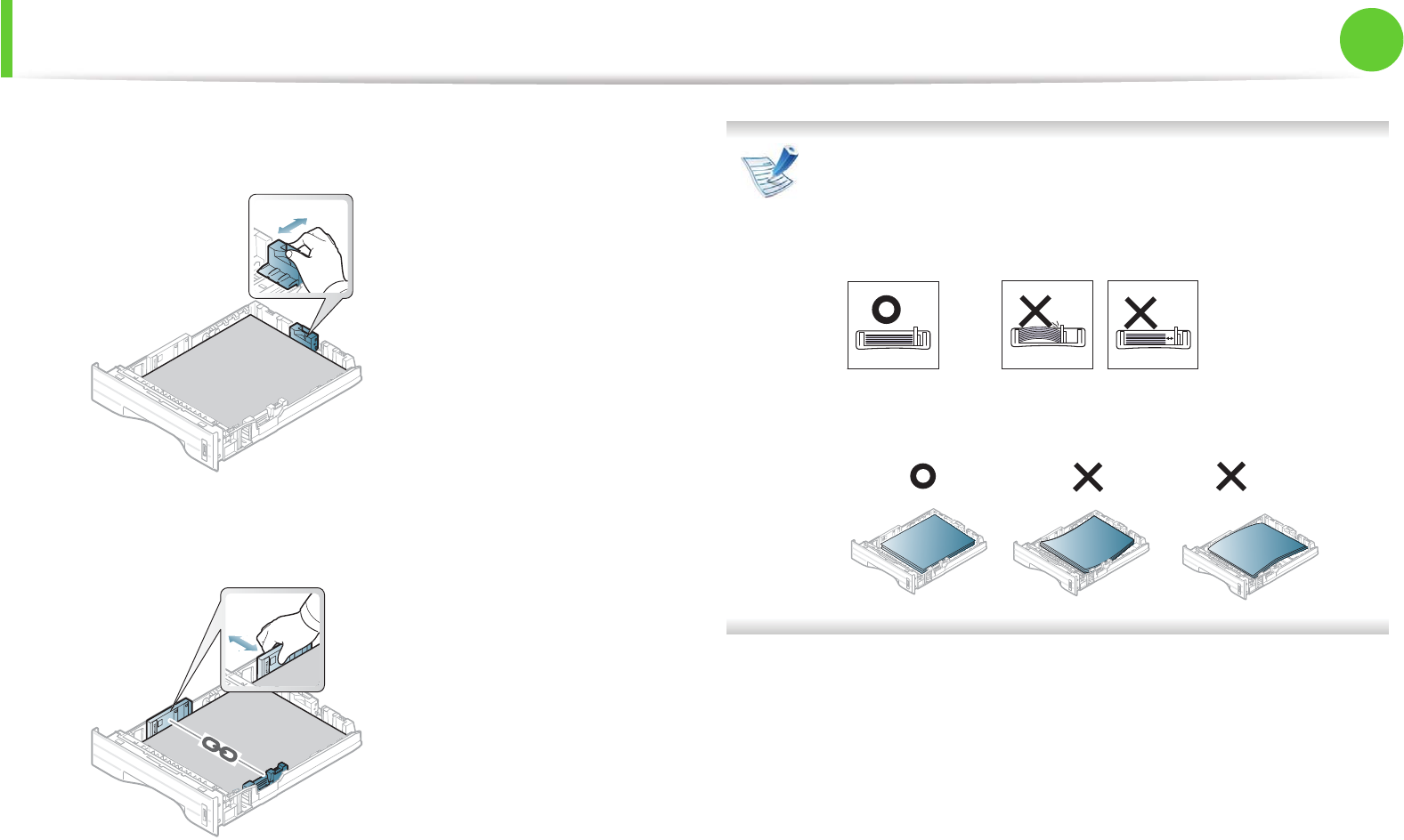
Media and tray 32
2. Menu overview and basic setup
4 Slide the paper length guide until it lightly touches the end of
the paper stack.
5 Squeeze the paper width guide and slide it to the edge of the
paper stack without causing it to bend.
• Do not push the paper width guide too far causing the
media to warp.
• If you do not adjust the paper width guide, it may cause
paper jams.
• Do not use a paper with a leading-edge curl, it may cause
a paper jam or the paper can be wrinkled.
6 Insert the tray back into the machine.
7 Set the paper type and size for tray 1 (see "Setting the paper
size and type" on page 40).
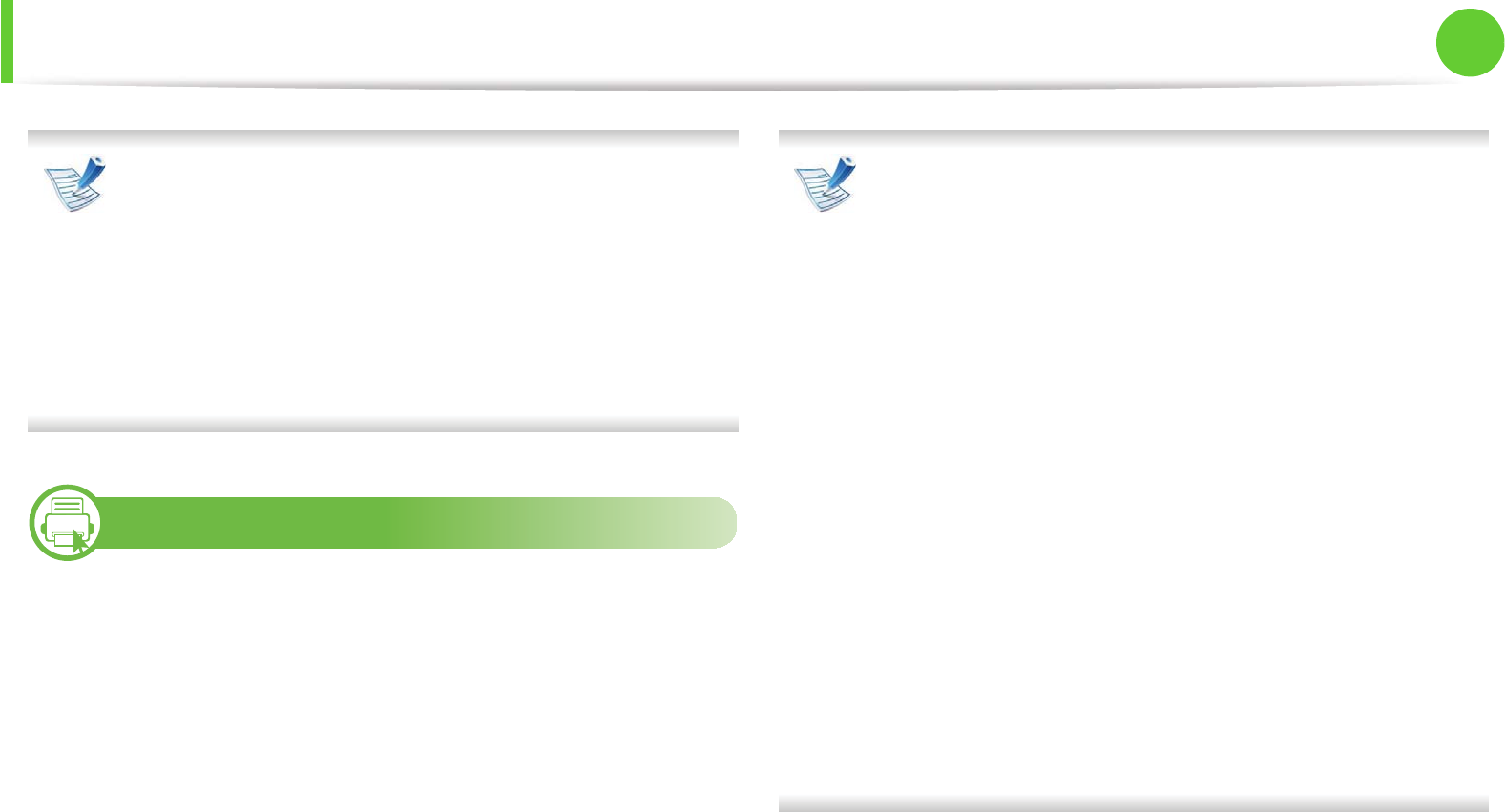
Media and tray 33
2. Menu overview and basic setup
The settings set from the machine driver override the
settings on the control panel.
a To print from an application, open an application and start
the print menu.
b Open Printing Preferences (see "Opening printing
preferences" on page 43).
c Press the Paper tab in Printing Preferences, and select an
appropriate paper type.
3
Loading in multi-purpose tray
The multi-purpose tray can hold special sizes and types of print
material, such as postcards, note cards, and envelopes.
•The machine does not have a display screen: 1 sheet of 80 g/
m2 (20 lbs bond)
•The machine has the display screen: 50 sheets of 80 g/m2 (20
lbs bond)
Tips on using the multi-purpose tray
• To prevent paper jams, do not add paper while printing
when there is still paper in the multi-purpose tray.
• Print media should be loaded face up with the top edge
going into the multi-purpose tray first and be placed in the
center of the tray.
• To ensure printing quality and to prevent paper jams, only
load the available paper (see "Print media specifications"
on page 83).
• Flatten any curl on postcards, envelopes, and labels before
loading them into the multi-purpose tray.
• When printing on special media, you must follow the
loading guidelines (see "Printing on special media" on
page 35).
• When papers overlap when printing using the multi-
purpose tray, open tray 1 and remove the overlapping
papers then try printing again.
• When paper does not feed well while printing, push the
paper in manually until it starts feeding automatically.
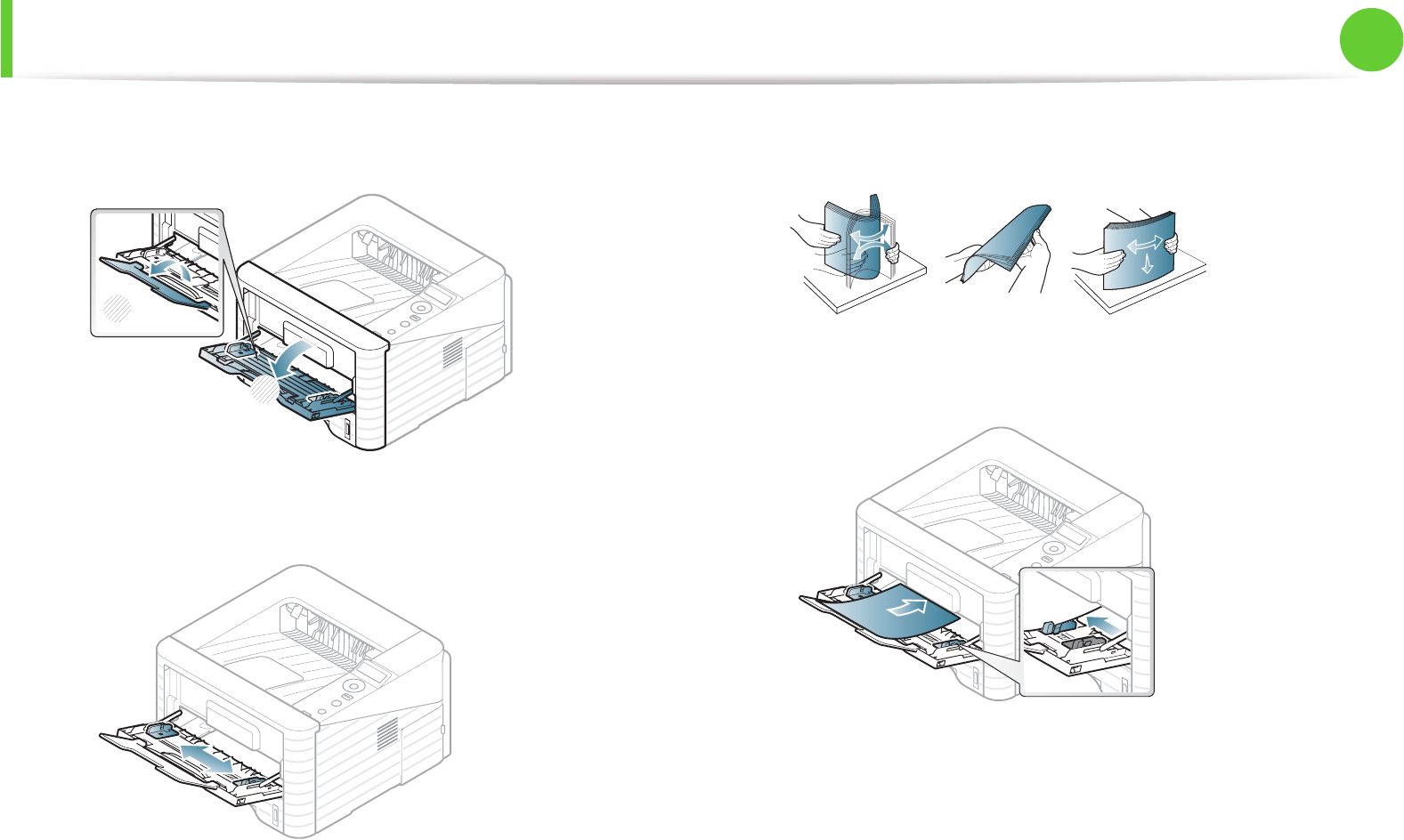
Media and tray 34
2. Menu overview and basic setup
1Open the multi-purpose tray and unfold the multi-purpose
tray extension, as shown.
2 Adjust the multi-purpose tray paper width guides to the width
of the paper.
3 Flex or fan the edge of the paper stack to separate the pages
before loading paper.
4 Load the paper. Squeeze the multi-purpose tray paper width
guides and adjust them to the width of the paper.
5 Set the paper type and size from the control panel (see
"Setting the paper size and type" on page 40).
1
2
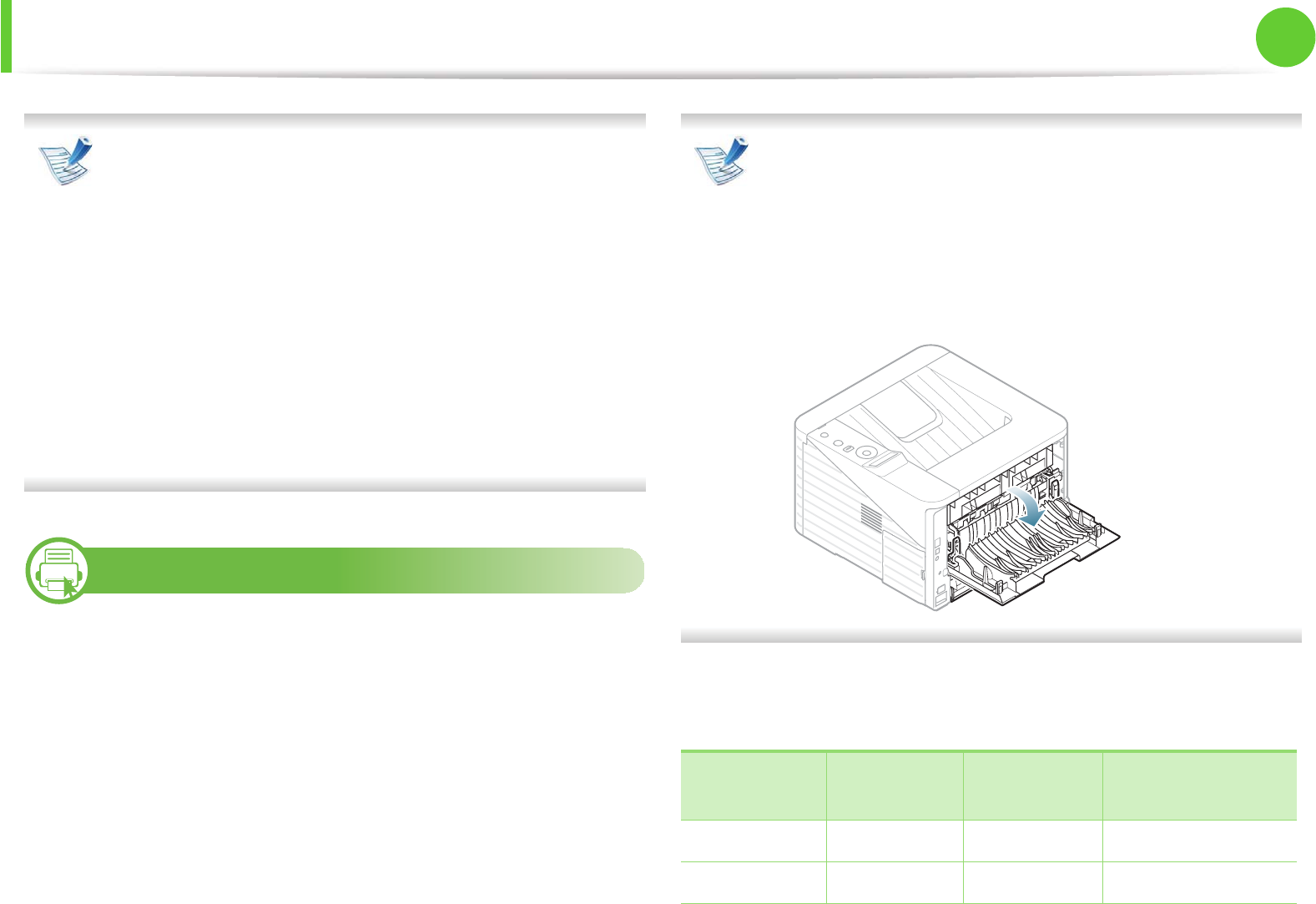
Media and tray 35
2. Menu overview and basic setup
The settings set from the machine’s driver override the
settings on the control panel.
a To print from an application, open an application and start
the print menu.
b Open Printing Preferences (see "Opening printing
preferences" on page 43).
c Press the Paper tab in Printing Preferences and select an
appropriate paper type.
For example, if you want to use a label, set the paper type
to Label.
d Select MP Tray in paper source, then press OK.
e Start printing in application.
4
Printing on special media
The table below shows the special media usable in each tray.
The media types are shown in the Printing Preferences. Select the
proper media type to get the highest printing quality.
• When using special media, we recommend you feed one
sheet at a time (see "Print media specifications" on page
83).
•Printing the special media (Face up)
If special media are printed out with curl, wrinkles, crease,
or black bold lines, open the rear cover and try printing
again. Keep the rear cover opened during printing.
To see for paper weights for each sheet, refer to "Print media
specifications" on page 83.
Types Tray 1 Optional
tray Multi-purpose tray
Plain ?? ?
Thick ?? ?

Media and tray 36
2. Menu overview and basic setup
( ?: Included, Blank: Not available)
Envelope
Printing successfully on envelopes depends upon the quality of the
envelopes.
To print an envelope, place it as shown in the following figure.
If envelopes are printed out with wrinkles, crease, or black bold lines,
open the rear cover and pull down the pressure lever on the right
side about 90 degrees and try printing again. Keep the rear cover
opened during printing.
Thicker ?
Thin ?? ?
Bond ?? ?
Color ?
CardStock ?? ?
Labels ?
Transparency ?
Envelope ?
Preprinted ?
Cotton ?
Recycled ?? ?
Archive ?? ?
Types Tray 1 Optional
tray Multi-purpose tray

Media and tray 37
2. Menu overview and basic setup
• When selecting envelopes, consider the following factors:
-Weight: should not exceed 90 g/m2 otherwise; jams may
occur.
-Construction: should lie flat with less than 6 mm curl and
should not contain air.
-Condition: should not be wrinkled, nicked, nor damaged.
-Temperature: should resist the heat and pressure of the
machine during operation.
• Use only well-constructed envelopes with sharp and well-
creased folds.
• Do not use stamped envelopes.
• Do not use envelopes with clasps, snaps, windows, coated lining,
self-adhesive seals, or other synthetic materials.
• Do not use damaged or poorly made envelopes.
• Be sure the seam at both ends of the envelope extends all the
way to the corner of the envelope.
1 Acceptable
2 Unacceptable
• Envelopes with a peel-off adhesive strip or with more than one
flap that folds over to seal must use adhesives compatible with
the machine’s fusing temperature for 0.1 second (about 170°C
(338 °F)). The extra flaps and strips might cause wrinkling,
creasing, or jams, and may even damage the fuser.
• For the best print quality, position margins no closer than 15 mm
from the edges of the envelope.
• Avoid printing over the area where the envelope’s seams meet.
1Pressure lever
1
1 2
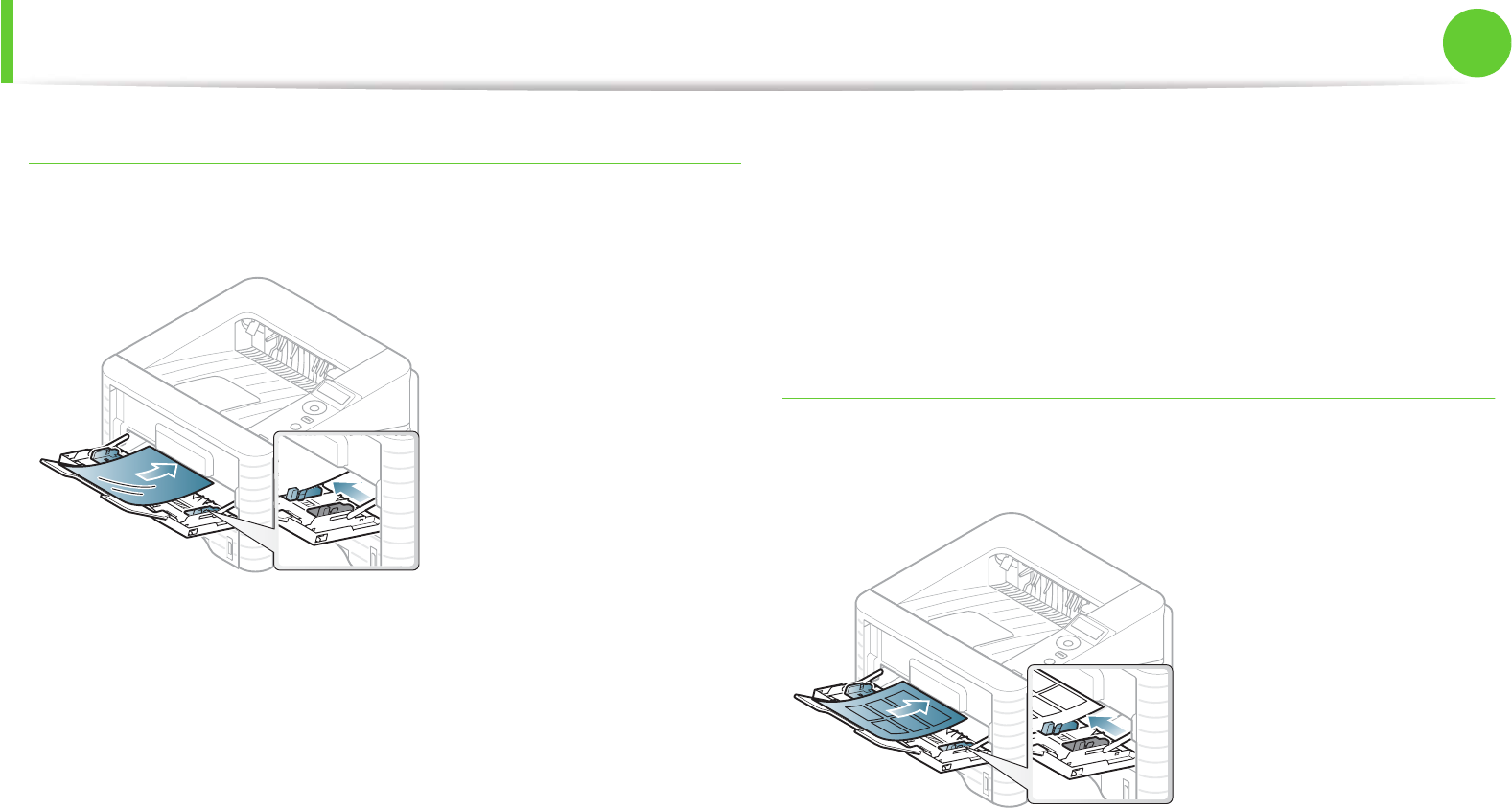
Media and tray 38
2. Menu overview and basic setup
Transparency
To avoid damaging the machine, use only transparencies designed
for use in laser printers.
• Must withstand the machine’s fusing temperature.
• Place them on a flat surface after removing them from the
machine.
• Do not leave unused transparencies in the paper tray for long.
Dust and dirt may accumulate on them, resulting in spotty
printing.
• To avoid smudging caused by fingerprints, handle them
carefully.
• To avoid fading, do not expose printed transparencies to
prolonged sunlight.
• Ensure that transparencies are not wrinkled, curled, or have any
torn edges.
• Do not use transparencies that separate from the backing sheet.
• To prevent transparencies from sticking to each other, do not let
the printed sheets stack up as they are being printed out.
• Recommended media: Transparency for a color laser printer by
Xerox, such as 3R 91331(A4), 3R 2780 (Letter)
Labels
To avoid damaging the machine, use only labels designed for use in
laser printers.
• When selecting labels, consider the following factors:
-Adhesives: Should be stable at your machine’s fusing
temperature. Check your machine’s specifications to view the
fusing temperature (about 170°C (338°F)).

Media and tray 39
2. Menu overview and basic setup
-Arrangement: Only use labels with no exposed backing
between them. Labels can peel off sheets that have spaces
between the labels, causing serious jams.
-Curl: Must lie flat with no more than 13 mm of curl in any
direction.
-Condition: Do not use labels with wrinkles, bubbles, or other
indications of separation.
• Make sure that there is no exposed adhesive material between
labels. Exposed areas can cause labels to peel off during printing,
which can cause paper jams. Exposed adhesive can also cause
damage to machine components.
• Do not run a sheet of labels through the machine more than
once. The adhesive backing is designed for only a single pass
through the machine.
• Do not use labels that are separating from the backing sheet or
are wrinkled, bubbled, or otherwise damaged.
Card stock/ Custom-sized paper
• In the software application, set margins at least 6.4 mm (0.25
inches) away from the edges of the material.
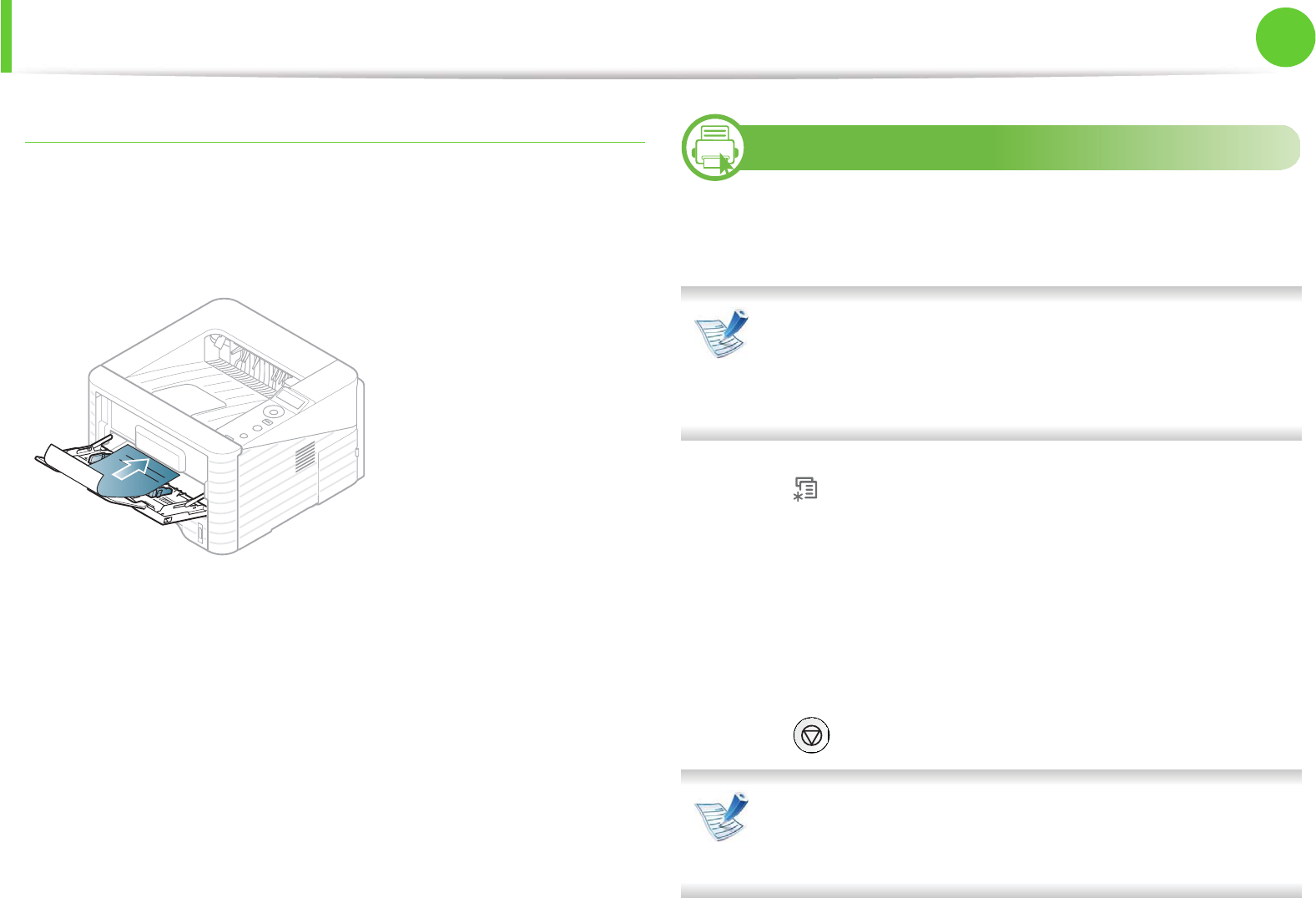
Media and tray 40
2. Menu overview and basic setup
Preprinted paper
When loading preprinted paper, the printed side should be facing up
with an uncurled edge at the front. If you experience problems with
paper feeding, turn the paper around. Note that print quality is not
guaranteed.
• Must be printed with heat-resistant ink that will not melt,
vaporize, or release hazardous emissions when subjected to the
machine’s fusing temperature for 0.1 second (about 170°C
(338°F)).
• Must be non-flammable and should not adversely affect machine
rollers.
• Before you load preprinted paper, verify that the ink on the paper
is dry. During the fusing process, wet ink can come off preprinted
paper, reducing print quality.
5
Setting the paper size and type
After loading paper in the paper tray, set the paper size and type
using the control panel buttons.
• The settings set from the machine’s driver override the
settings on the control panel.
• For models that do not have the display screen on the
control panel, this feature is not applicable.
1Press (Menu) button on the control panel.
2 Press Paper > OK > Select the tray you want > OK.
3 Press Paper Size > OK > Select the option you want > OK.
4 Press Paper Type > OK > Select the option you want > OK
5 Press (Cancel) to return to ready mode.
If you want to use special-sized paper such as billing paper,
select Custom in the Paper tab in the Printing Preferences
(see "Opening printing preferences" on page 43).
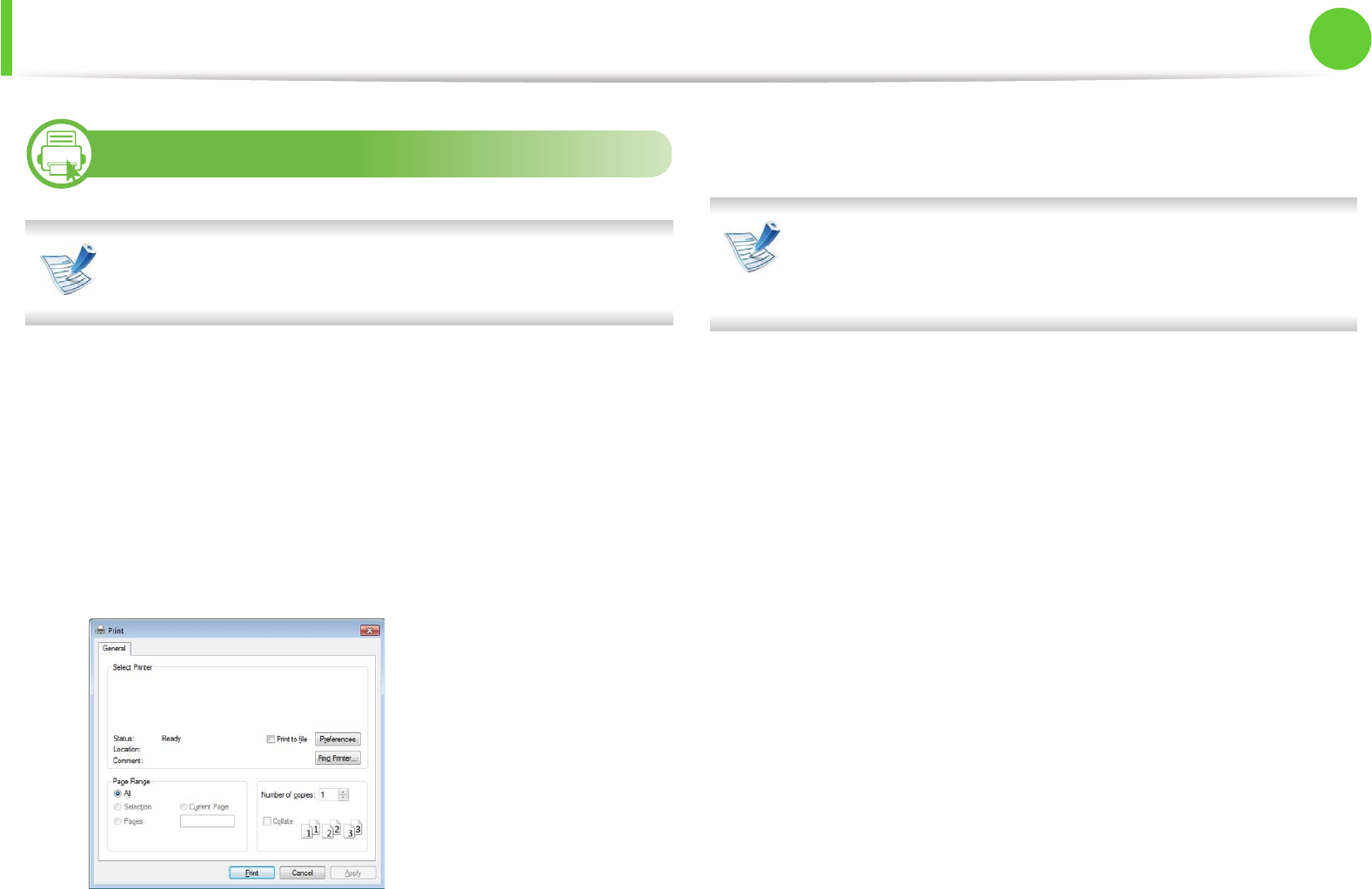
41
2. Menu overview and basic setup
Basic printing
6
Printing
If you are a Macintosh, Linux, or Unix OS user, refer to the
Advanced Guide.
The following Printing Preferences window is for Notepad in
Windows 7.
1Open the document you want to print.
2 Select Print from the File menu.
3 Select your machine from the Select Printer list.
4 The basic print settings including the number of copies and
print range are selected within the Print window.
To take advantage of the advanced printing features, click
Properties or Preferences from the Print window (see
"Opening printing preferences" on page 43).
5 To start the print job, click OK or Print in the Print window.

Basic printing 42
2. Menu overview and basic setup
7
Canceling a print job
If the print job is waiting in the print queue or print spooler, cancel
the job as follows:
• You can access this window by simply double-clicking the
machine icon ( ) in the Windows task bar.
• You can also cancel the current job by pressing (Cancel) on
the control panel.
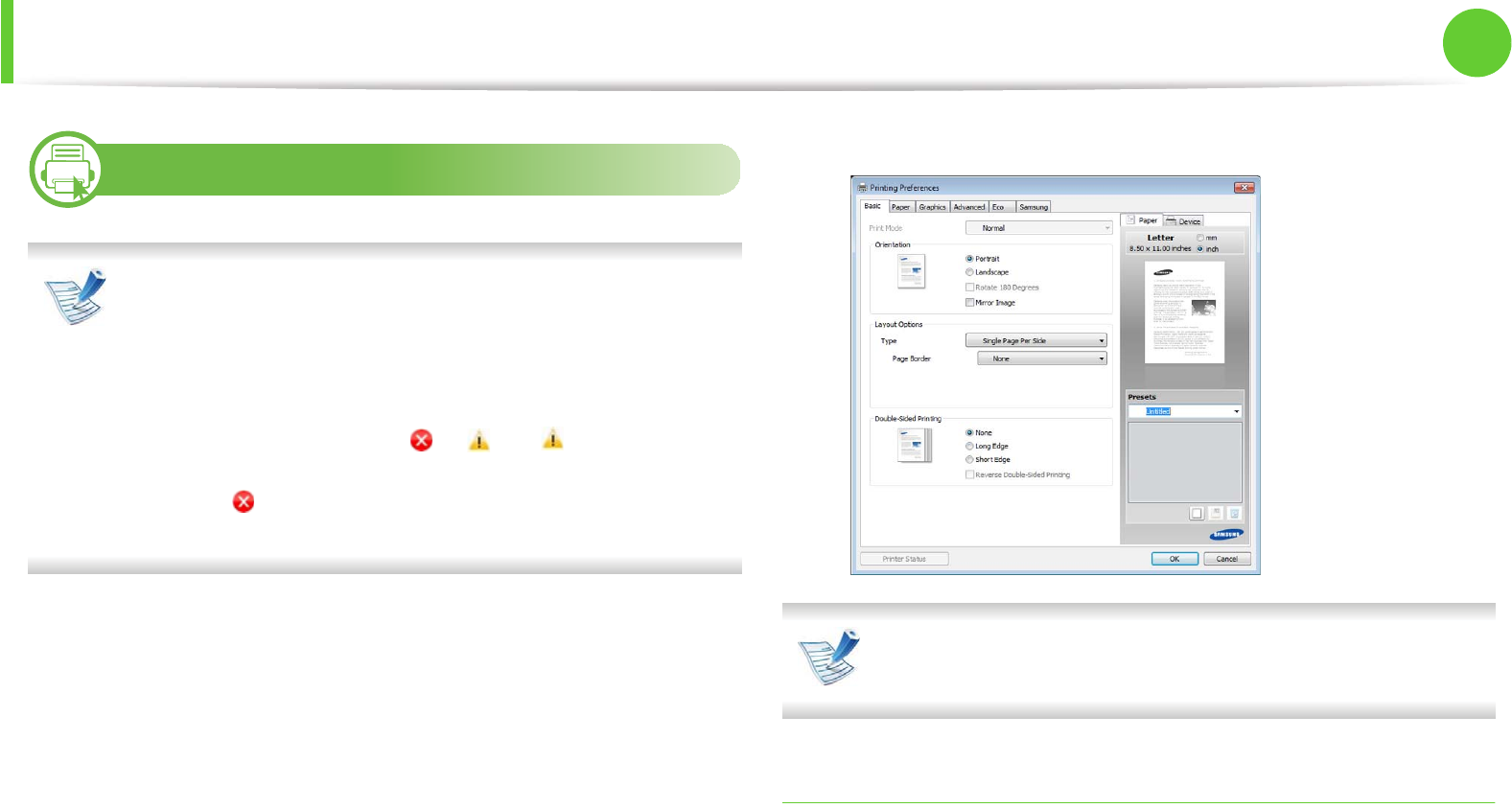
Basic printing 43
2. Menu overview and basic setup
8
Opening printing preferences
•The Printing Preferences window that appears in this
user’s guide may differ depending on the machine in use.
However, the composition of the Printing Preferences
window is similar.
• When you select an option in Printing Preferences, you
may see a warning mark or . An mark means you
can select that certain option but it is not recommended,
and an mark means you cannot select that option due
to the machine’s setting or environment.
1Open the document you want to print.
2 Select Print from the file menu.
3 Select your machine from the Select Printer.
4 Click Properties or Preferences.
You can check the machine's current status using the Printer
Status button (see Advanced Guide).
Using a favorite setting
The Presets option, which is visible on each preferences tab except
for the Samsung tab, allows you to save the current preferences for
future use.
To save a Presets item, follow these steps:
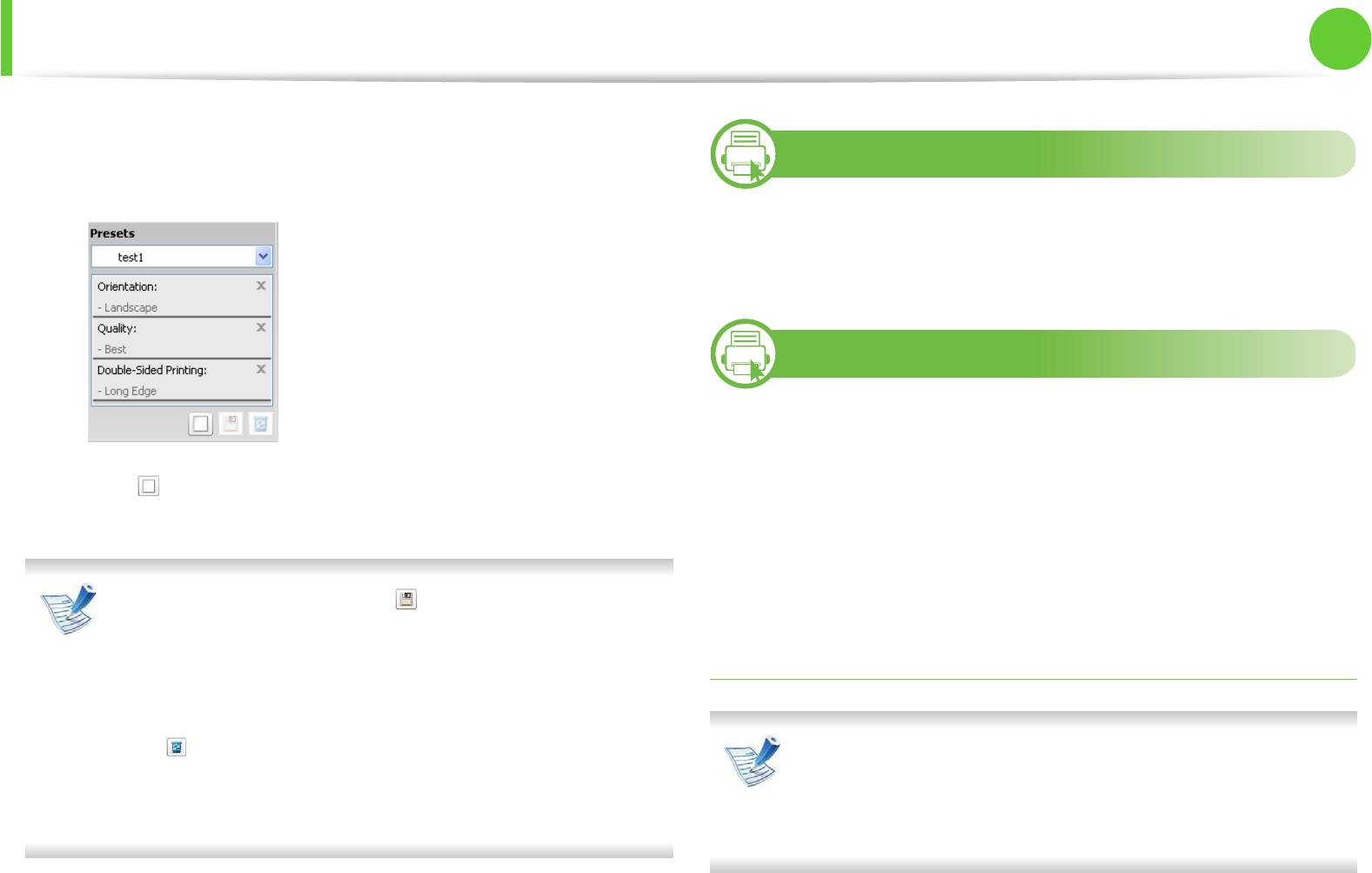
Basic printing 44
2. Menu overview and basic setup
1Change the settings as needed on each tab.
2 Enter a name for the item in the Presets input box.
3 Click (Add). When you save Presets, all current driver
settings are saved.
Select more options and click (Update), settings will be
added to the Presets you made. To use a saved setting, select
it from the Presets drop-down list. The machine is now set to
print according to the settings you have selected. To delete
saved settings, select it from the Presets drop-down list and
click (Delete).
You can also restore the printer driver’s default settings by
selecting Default Preset from the Presets drop-down list.
9
Using help
Click the option you want to know on the Printing Preferences
window and press F1 on your keyboard.
10
Eco printing
The Eco function cuts toner consumption and paper usage. The Eco
function allows you to save print resources and lead you to eco-
friendly printing.
If you press the Eco button from the control panel, eco mode is
enabled. The default setting of eco mode is duplex (long edge), 2-up,
skip blank pages, and toner save.
Setting eco mode on the control panel
• The settings set from the machine’s driver override the
settings on the control panel.
• For models that do not have the display screen on the
control panel, this feature is not applicable.

45
2. Menu overview and basic setup
1Press (Menu) button on the control panel.
2 Press System Setup > OK > Eco Setup > OK.
3 Press OK select the mode you want.
•Default Mode: Select this to turn on or off the eco mode.
(Duplex (long edge)/Toner save/2-up/Skip blank pages)
-Off: Set the eco mode off.
-On: Set the eco mode on.
If you set the eco mode on with a password from the
SyncThru™ Web Service ( Settings tab > Machine Settings >
System > Eco > Settings), the Onforce message appears.
You have to enter the password to change the eco mode
status.
•Change Temp.: Select the eco template.
-Default Eco: The default setting of eco mode is duplex,
2-up, skip blank pages, and toner save.
-Custom Eco: Follow the settings from Syncthru™ Web
Service. Before you select this item, you must set the
eco function in SyncThru™ Web Service> Settings tab
> Machine Settings > System > Eco > Settings.
Setting eco mode on the driver
Open the Eco tab to set eco mode. When you see the eco image
( ), that means the eco mode is currently enabled.
ŹEco options
•Printer Default: Follows the settings from the machine's control
panel.
•None: Disables eco mode.
•Eco Printing: Enables eco mode. Activate the various eco items
you want to use.
•Password: If the administrator fixed to enable the eco mode, you
have to enter the password to change the status.

Basic printing 46
2. Menu overview and basic setup
ŹResult simulator
Result Simulator shows the results of reduced emission of carbon
dioxide, used electricity, and the amount of saved paper in
accordance with the settings you selected.
• The results are calculated on the basis that the total number of
printed paper is one hundred without a blank page when the eco
mode is disabled.
• Refer to the calculation coefficient about CO2, energy, and paper
from IEA, the index of Ministry of Internal Affairs and
Communication of Japan and www.remanufacturing.org.uk.
Each model has a different index.
• The power consumption in printing mode refers to the average
printing power consumption of this machine.
• The actual saved or reduced amount may differ depending on
the operating system used, computing performance, application
software, connection method, media type, media size, job
complexity, etc.
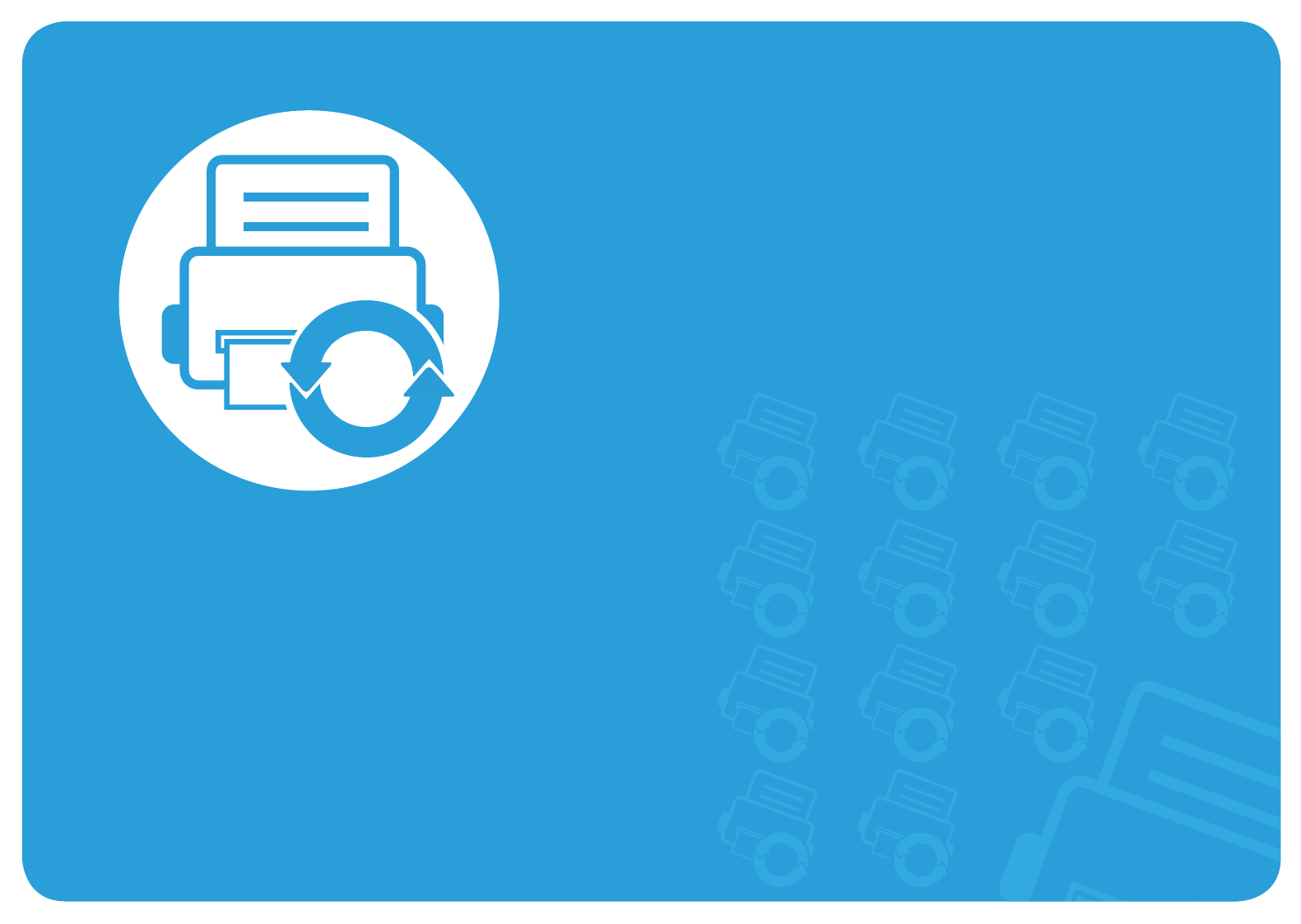
3. Maintenance
This chapter provides information about purchasing supplies, accessories
and maintenance parts available for your machine.
• Ordering supplies and accessories 48
• Available supplies 49
• Available accessories 50
• Available maintenance parts 51
• Redistributing toner 52
• Replacing the toner cartridge 54
• Upgrading a memory module 56
• Monitoring the supplies life 58
• Setting the toner low alert 59
• Cleaning the machine 60

48
3. Maintenance
Ordering supplies and accessories
Available accessories may differ from country to country. Contact your sales representatives to obtain the list of available supplies, and
maintenance parts.
To order Samsung-authorized supplies, accessories, and maintenance parts, contact your local Samsung dealer or the retailer where you
purchased your machine. You can also visit www.samsung.com/supplies, and then select your country/region to obtain the contact
information for service.
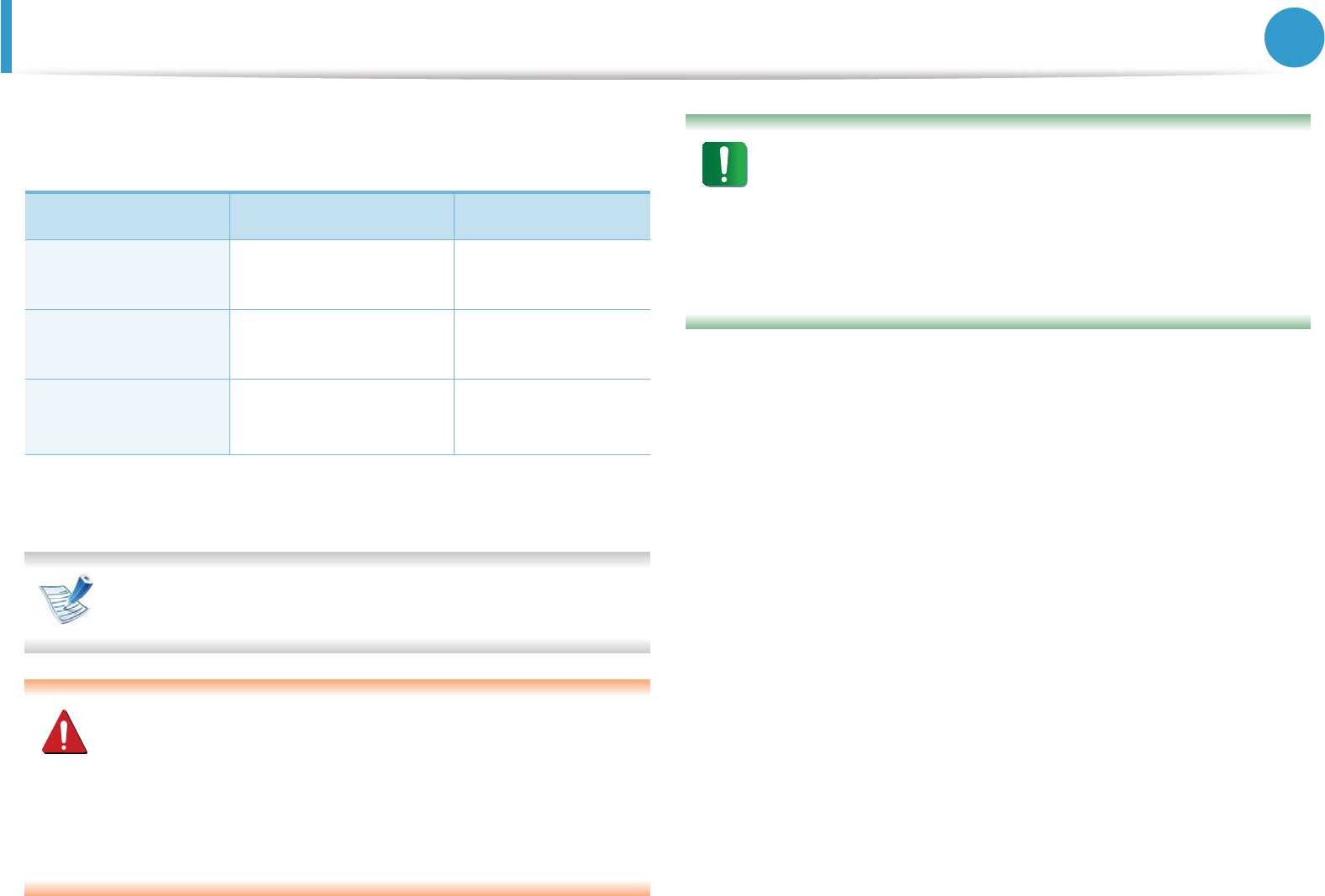
49
3. Maintenance
Available supplies
When supplies reach the end of their life spans, you can order the
following types of supplies for your machine:
Depending on the options and job mode used, the toner
cartridge’s lifespan may differ.
When purchasing new toner cartridges or other supplies,
these must be purchased in the same country as the machine
you are using. Otherwise, new toner cartridges or other
supplies will be incompatible with your machine due to
different configurations of toner cartridges and other
supplies according to the specific country conditions.
Samsung does not recommend using non-genuine Samsung
toner cartridge such as refilled or remanufactured toner.
Samsung cannot guarantee non-genuine Samsung toner
cartridge's quality. Service or repair required as a result of
using non-genuine Samsung toner cartridges will not be
covered under the machine’s warranty.
Type Average yielda
a. Declared yield value in accordance with ISO/IEC 19752.
Part name
Standard yield
toner cartridge
Approx. 2,000 pages MLT-D205S
High yield toner
cartridge
Approx. 5,000 pages MLT-D205L
Extra high yield
toner cartridgeb
b. The toner cartridge is available only for ML-371x Series.
Approx. 10,000 pages MLT-D205E

50
3. Maintenance
Available accessories
You can purchase and install accessories to enhance your machine’s performance and capacity.
Some features and optional goods may not be available depending on models or countries (see "Features by models" on page 7).
Accessory Function Part name
Memory module Extends your machine’s memory capacity. • CLP-MEM201: 128 MB
• CLP-MEM202: 256 MB
Tray 2 If you are experiencing frequent paper supply problems, you can attach an
additional tray.
ML-S3710A
IEEE 1284 parallel
connector
Allows you to use various interface.
• When installing the printer driver with an IEEE1284 parallel
connector, the machine might not be found and after installing
the printer driver, only basic printing features are available.
• If you want to check the machine's status or set the settings,
connect the machine to a computer with a USB cable or a
network.
• If you use the IEEE 1284 parallel connector, you can not use the
USB cable.
ML-PAR100

51
3. Maintenance
Available maintenance parts
To purchase maintenance parts, contact the source where you bought the machine. Replacing maintenance parts can be performed only by
an authorized service provider, dealer, or the retailer where you bought the machine. The warranty does not cover the replacement of any
maintenance parts once it has reached its “Average yield”.
Maintenance parts are replaced at specific intervals to avoid print quality and paper feed problems resulting from worn parts, see table below.
The purpose of which is to maintain your machine in top working condition. The maintenance parts below should be replaced when the life
span of each item has been met.
Parts Average yielda
a. It will be affected by the operating system used, computing performance, application software, connecting method, media
type, media size and job complexity.
Transfer roller Approx. 100,000 pages
Fuser unit Approx. 90,000 pages
Pickup roller Approx. 90,000 pages
Retard roller Approx. 60,000 pages
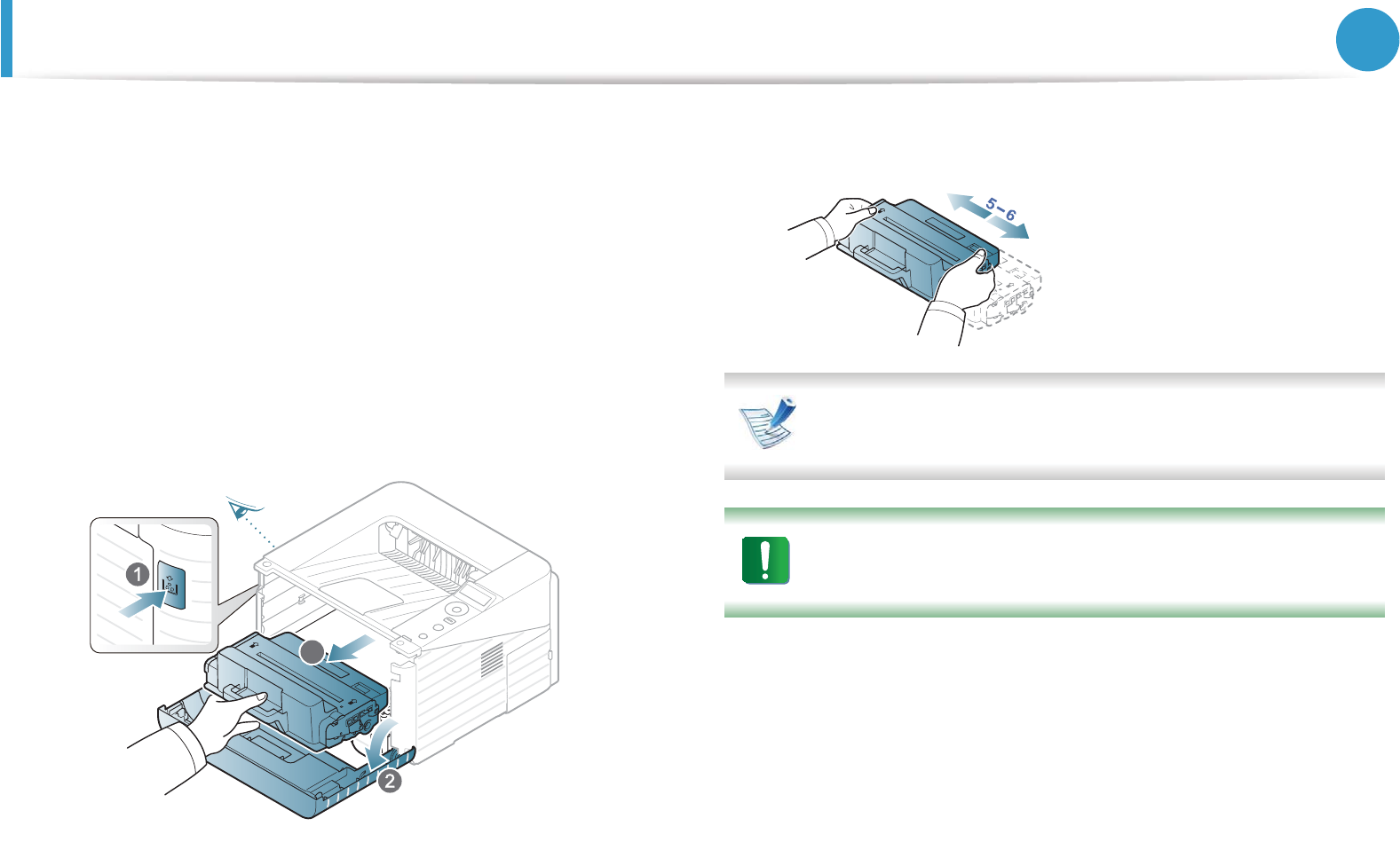
52
3. Maintenance
Redistributing toner
When the toner cartridge is near the end of its life:
• White streaks or light printing occurs and/or density variation
side to side.
•The Status LED blinks red.
If this happens, you can temporarily improve print quality by
redistributing the remaining toner in the cartridge. In some cases,
white streaks or light printing will still occur even after you have
redistributed the toner.
1Open the front cover and pull the toner cartridge out.
2 Thoroughly roll the cartridge five or six times to distribute the
toner evenly inside the cartridge.
If toner gets on your clothing, wipe it off with a dry cloth and
wash clothing in cold water: hot water sets toner into fabric.
Do not touch the green underside of the toner cartridge. Use
the handle on the cartridge to avoid touching this area.
3 Hold the toner cartridge by the handle and slowly insert the
cartridge into the opening in the machine.
3
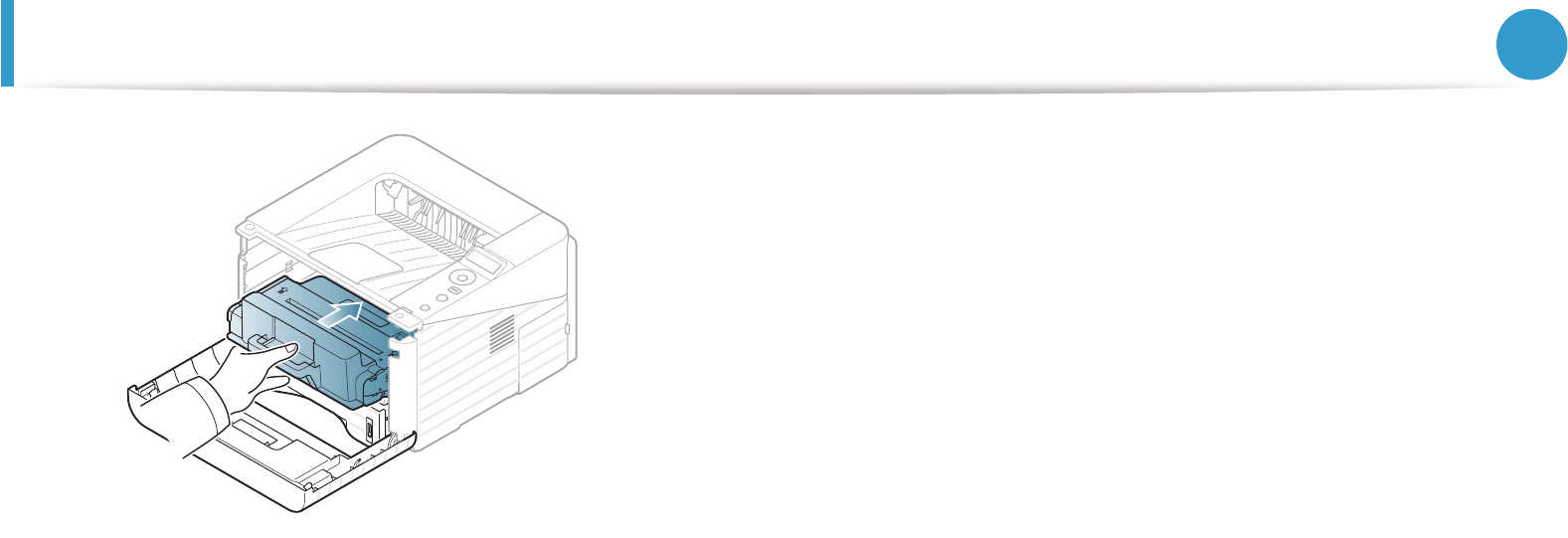
Redistributing toner 53
3. Maintenance
4 Close the front cover. Ensure that the cover is securely closed.

54
3. Maintenance
Replacing the toner cartridge
Click this link to open an animation about replacing a toner
cartridge.
When a toner cartridge has reached the end of life, the machine will
stop printing.
1Open the front cover and pull the toner cartridge out.
2 Remove the new toner cartridge from its bag.
3 Remove the label from the toner cartridge as shown below.
4 Thoroughly shake side to side the cartridge five or six times to
distribute the toner evenly inside the cartridge.
If toner gets on your clothing, wipe it off with a dry cloth and
wash clothing in cold water: hot water sets toner into fabric.
Do not touch the green underside of the toner cartridge. Use
the handle on the cartridge to avoid touching this area.
3

Replacing the toner cartridge 55
3. Maintenance
5 Hold the toner cartridge by the handle and slowly insert the
cartridge into the opening in the machine.
6 Close the front cover. Make sure that the cover is securely
closed.
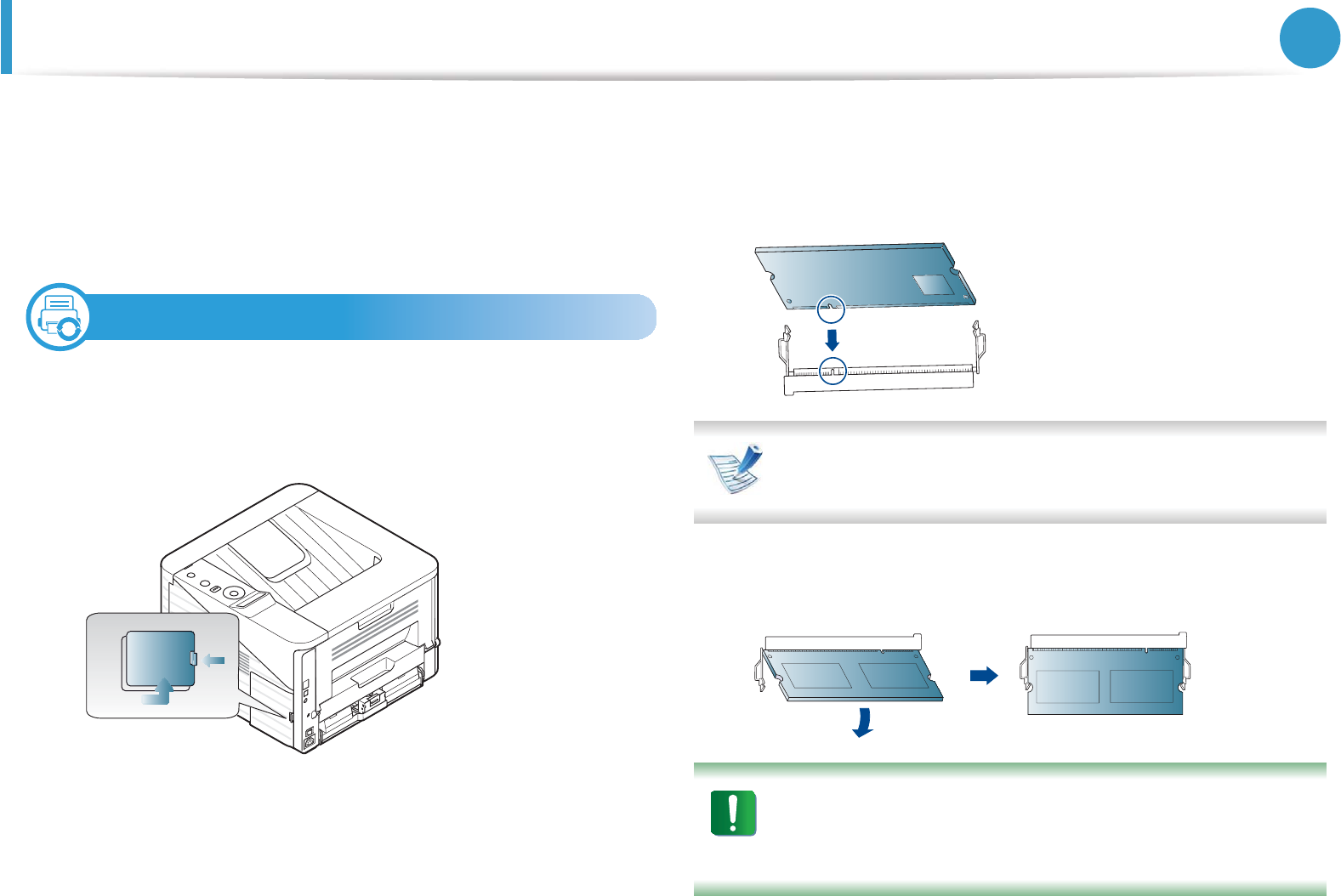
56
3. Maintenance
Upgrading a memory module
Your machine has a dual in-line memory module (DIMM). Use this
memory module slot to install additional memory.
Order information is provided for additional memory module. (See
"Available accessories" on page 50.)
1
Installing a memory module
1Turn the machine off and unplug all cables from the machine.
2 Grasp the control board cover and remove it.
3 Remove the new memory module from its bag.
4 Holding the memory module by the edges, align the memory
module on the slot at about a 30-degree tilt. Make sure that
the notches of the module and the grooves on the slot fit each
other.
The notches and grooves illustrated above may not match
those on an actual memory module and its slot.
5 Press the memory module into the slot with care until you
hear a ‘click’.
Do not press the memory module strongly or the module
may be damaged. If the module does not seem to fit into the
slot properly, carefully try the previous procedure again.

Upgrading a memory module 57
3. Maintenance
6 Replace the control board cover.
7 Reconnect the power cord and machine cable and turn the
machine on.
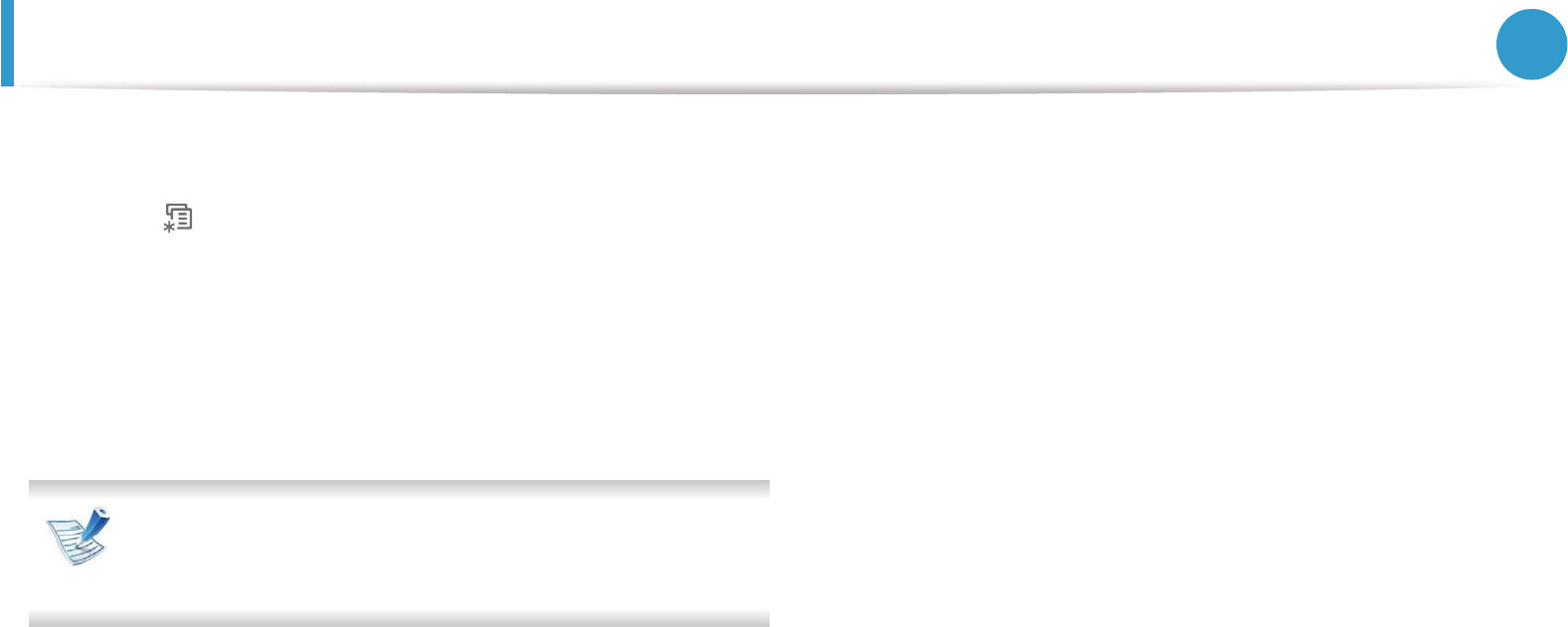
58
3. Maintenance
Monitoring the supplies life
To view the supply life indicators, follow the steps below:
1Press (Menu) on the control panel.
2 Press System Setup > OK > Maintenance > OK.
3 Press Supplies Info > OK.
4 Press OK to select the option you want.
For models that do not support the display screen on the
control panel, this feature is not applicable.
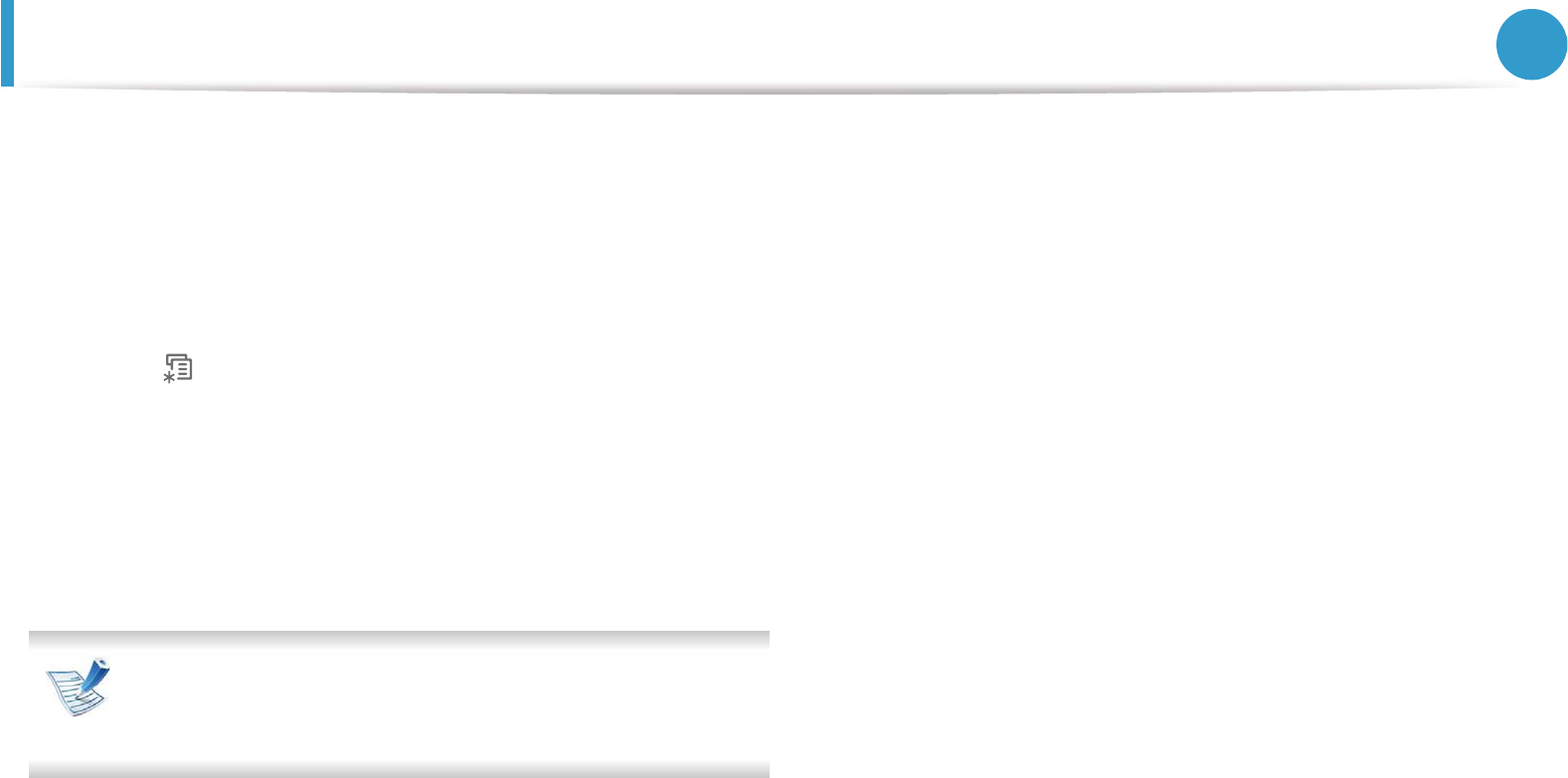
Setting the toner low alert 59
3. Maintenance
Setting the toner low alert
If the amount of toner in the cartridge is low, a message or LED
informing the user to change the toner cartridge appears. You can
set the option for whether or not this message or LED appears.
1Press (Menu) on the control panel.
2 Press System Setup > OK > Maintenance > OK.
3 Press Toner Low Alert > OK.
4 Select the option you want, then press OK.
For models that do not support the display screen on the
control panel, this feature is not applicable.
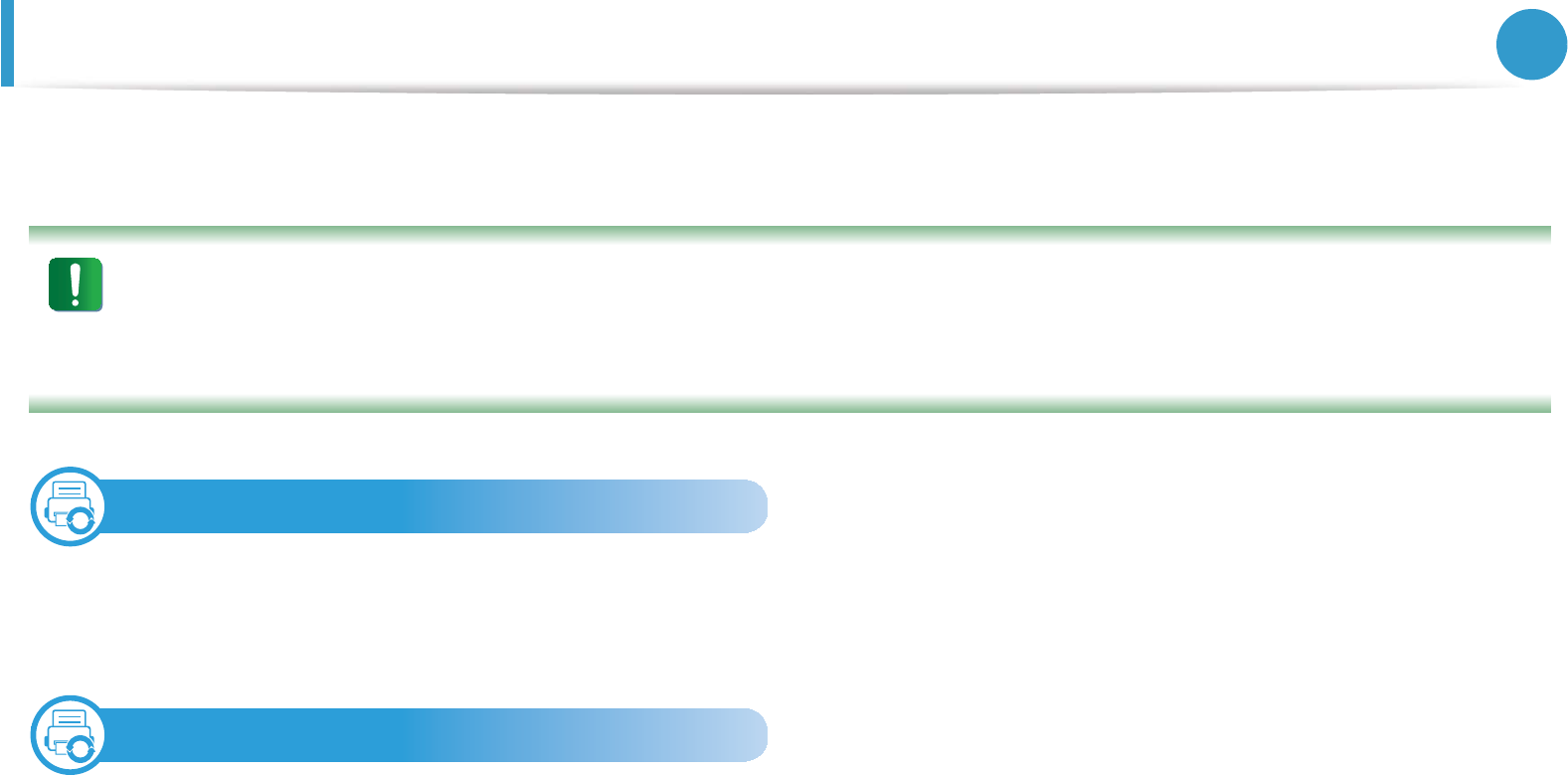
60
3. Maintenance
Cleaning the machine
If printing quality problems occur or if you use your machine in a dusty enviroment, you need to clean your machine regularly to keep it in
the best printing condition and use your machine longer.
• Cleaning the cabinet of the machine with cleaning materials containing large amounts of alcohol, solvents, or other strong substances
can discolor or distort the cabinet.
• If your machine or the surrounding area is contaminated with toner, we recommend you use a cloth or tissue dampened with water
to clean it. If you use a vacuum cleaner, toner blows in the air and might be harmful to you.
2
Cleaning the outside
Clean the machine cabinet with a soft, lint-free cloth. Dampen the cloth slightly with water, but be careful not to let any water drip onto or
into the machine.
3
Cleaning the inside
During the printing process, paper, toner, and dust particles can accumulate inside the machine. This buildup can cause print quality
problems, such as toner specks or smearing. Cleaning the inside of the machine clears and reduces these problems.
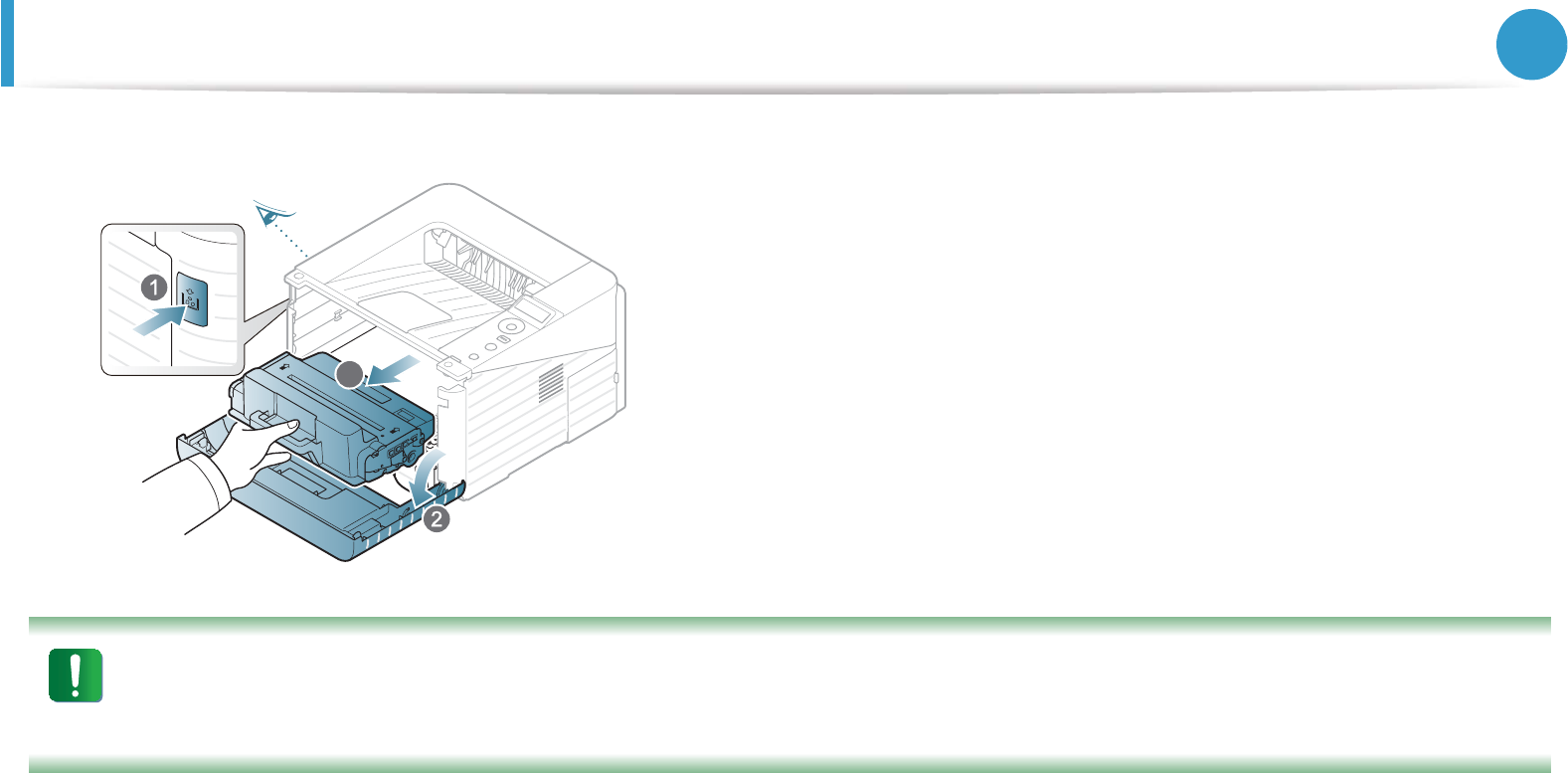
61
3. Maintenance
1Turn the machine off and unplug the power cord. Wait for the machine to cool down.
2 Open the front cover and pull the toner cartridge out. Set it on a clean flat surface.
• To prevent damage to the toner cartridge, do not expose it to light for more than a few minutes. Cover it with a piece of paper, if
necessary.
• Do not touch the green surface underside of the toner cartridge. Use the handle on the cartridge to avoid touching this area.
3
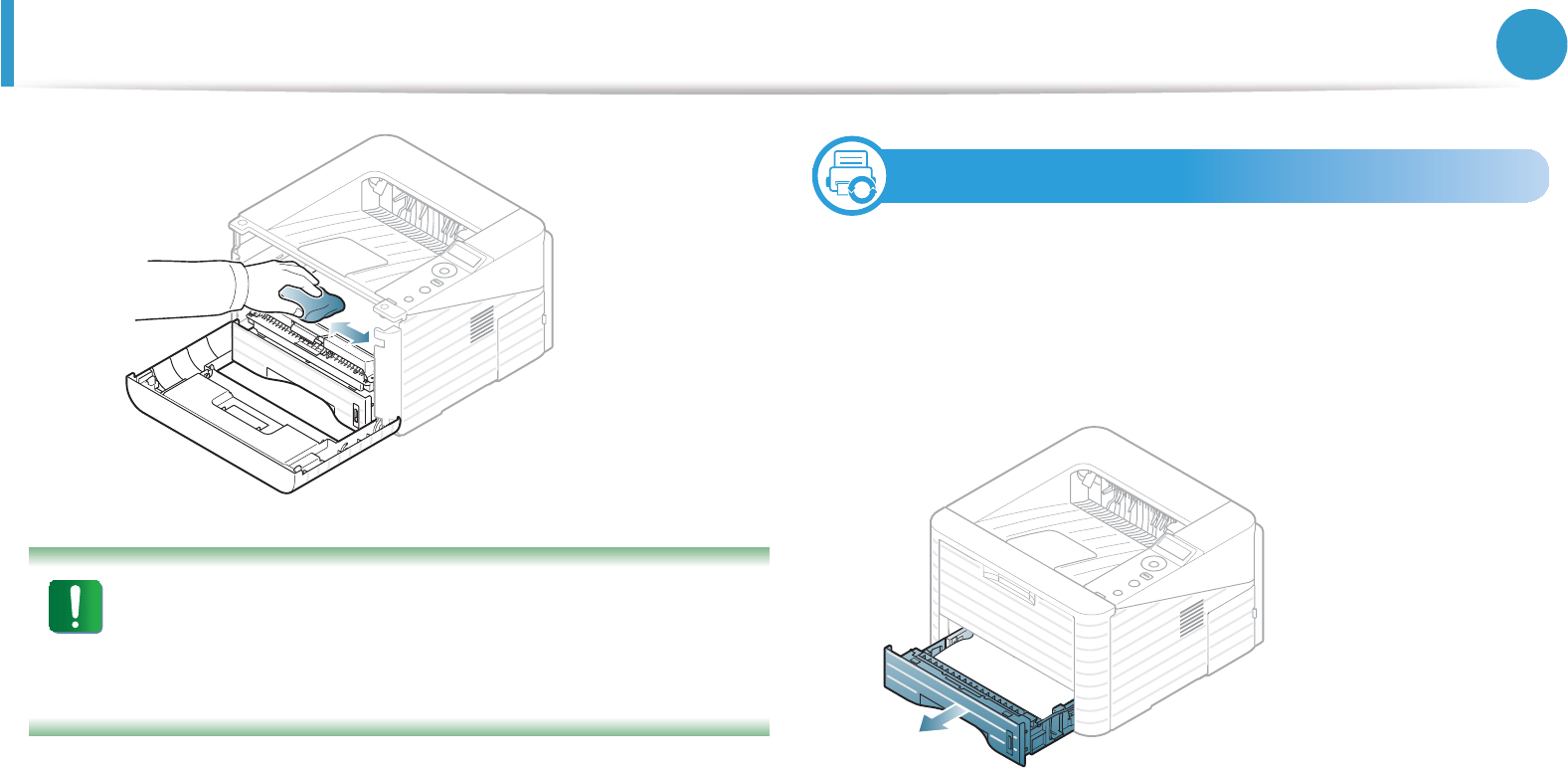
62
3. Maintenance
3 With a dry, lint-free cloth, wipe away any dust and spilled toner from the toner cartridge area.
While cleaning the inside of the machine, be careful not to
damage the transfer roller or any other inside parts. Do not
use solvents such as benzene or thinner. Printing quality
problems can occur and cause damage to the machine.
4 Reinsert the toner cartridge and close the front cover.
4
Cleaning the pickup roller
1Turn the machine off and unplug the power cord. Wait for the
machine to cool down.
2 Pull out tray 1.

Cleaning the machine 63
3. Maintenance
3 Clean the pickup roller with a soft, lint-free cloth.
4 Insert the tray back into the machine.

4. Troubleshooting
This chapter gives helpful information for what to do if you encounter an
error.
• Tips for avoiding paper jams 65
• Clearing paper jams 66
• Understanding the status LED 72
• Understanding display messages 75
This chapter gives helpful information for what to do if you
encounter an error.
If your machine has a display screen, check the message on the
display screen first to solve the error. If you cannot find a solution
to your problem in this chapter, refer to the Troubleshooting
chapter in the Advanced User's Guide.
If you cannot find a solution in the User's Guide or the problem
persists, call for service.

65
4. Troubleshooting
Tips for avoiding paper jams
By selecting the correct media types, most paper jams can be avoided. To avoid paper jams, refer to the following guidelines:
• Ensure that the adjustable guides are positioned correctly (see "Tray overview" on page 30).
• Do not overload the tray. Ensure that the paper level is below the paper capacity mark on the inside of the tray.
• Do not remove paper from the tray while your machine is printing.
• Flex, fan, and straighten paper before loading.
• Do not use creased, damp, or highly curled paper.
• Do not mix paper types in a tray.
• Use only recommended print media (see "Print media specifications" on page 83).
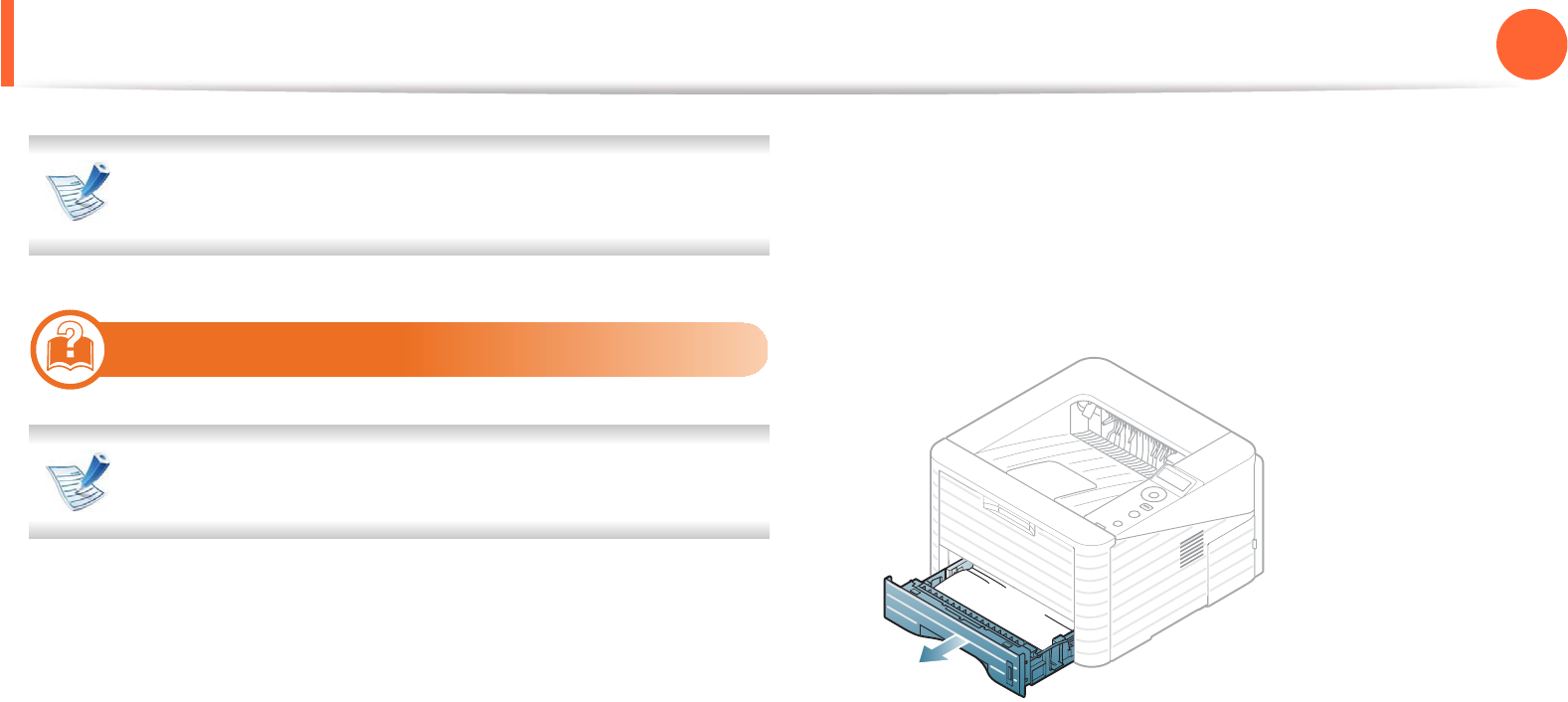
66
4. Troubleshooting
Clearing paper jams
To avoid tearing the paper, pull the jammed paper out slowly
and gently.
1
In tray 1
Click this link to open an animation about clearing a jam.
1Open and close the front cover. The jammed paper is
automatically ejected from the machine.
If the paper does not exit, go to the next step.
2 Pull out tray 1 .
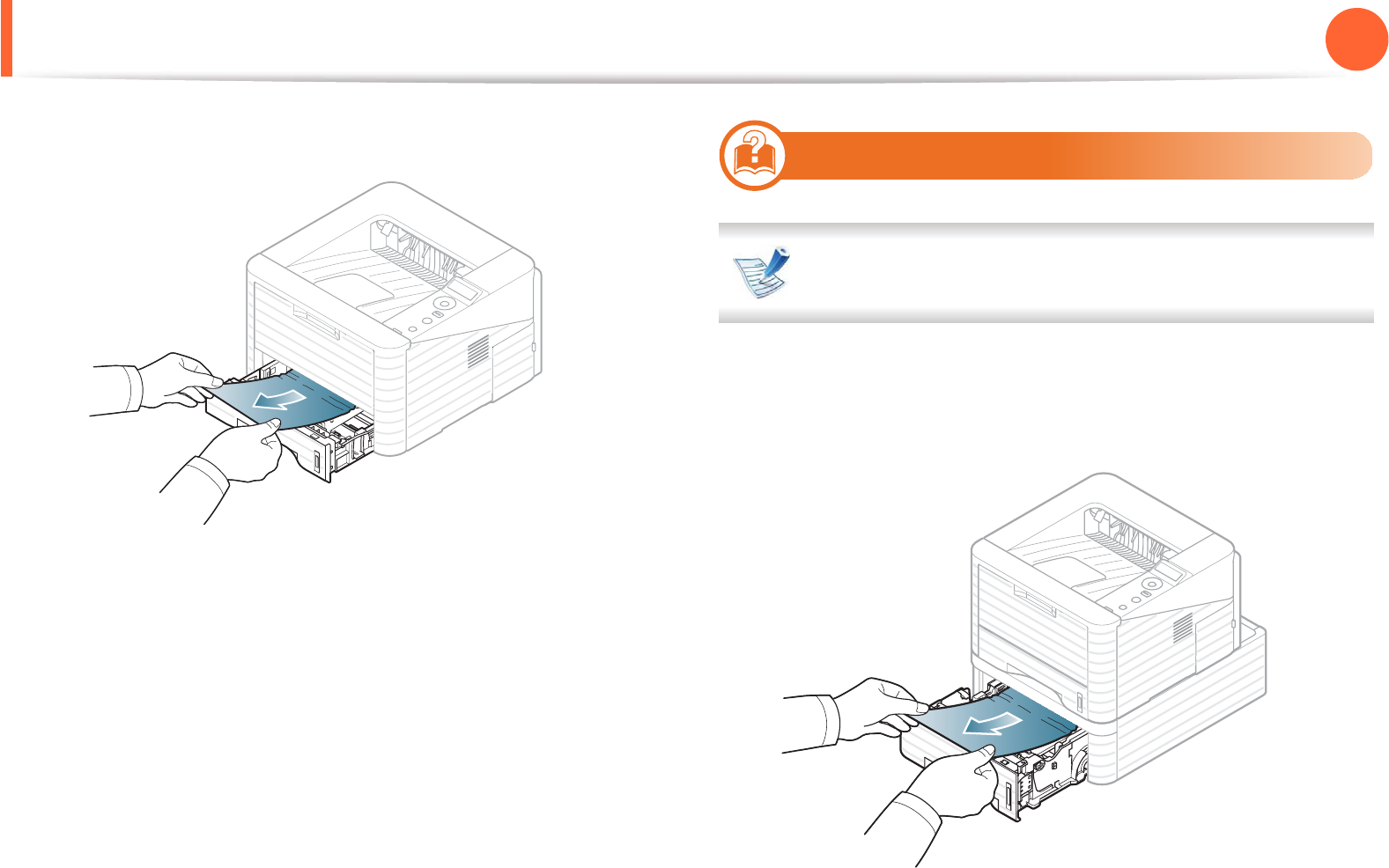
Clearing paper jams 67
4. Troubleshooting
3 Remove the jammed paper by gently pulling it straight out.
If the paper does not move when you pull, or if you do not see
the paper in this area, check the fuser area around the toner
cartridge (see "Inside the machine" on page 68).
4 Insert tray 1 back into the machine until it snaps into place.
Printing automatically resumes.
2
In optional tray2
Click this link to open an animation about clearing a jam.
1Pull out optional tray 2.
2 Remove the jammed paper from the machine.
If the paper does not move when you pull or if you do not see
the paper in this area, stop and go to the next step.

Clearing paper jams 68
4. Troubleshooting
3 Pull tray 1 half-way out.
4 Pull the paper straight up and out.
5 Insert the trays back into the machine. Printing automatically
resumes.
3
In the multi-purpose tray
Click this link to open an animation about clearing a jam.
1If the paper is not feeding properly, pull the paper out of the
machine.
2 Open and close the front cover to resume printing.
4
Inside the machine
Click this link to open an animation about clearing a jam.
The fuser area is hot. Take care when removing paper from
the machine.
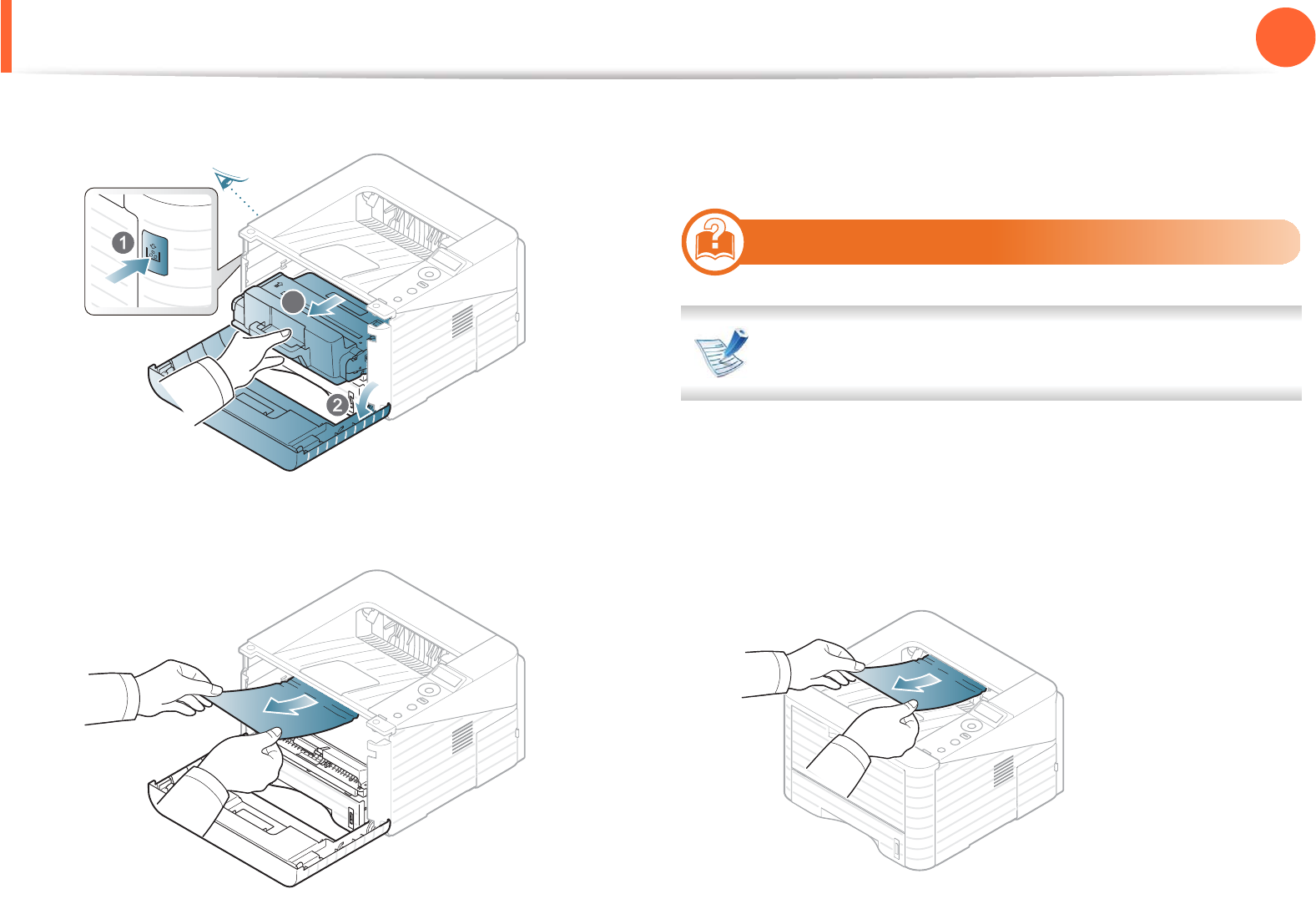
Clearing paper jams 69
4. Troubleshooting
1Open the front cover and pull the toner cartridge out.
2 Remove the jammed paper by gently pulling it straight out.
3 Replace the toner cartridge and close the front cover. Printing
automatically resumes.
5
In the exit area
Click this link to open an animation about clearing a jam.
1Open and close the front cover. The jammed paper is
automatically ejected from the machine.
If you do not see the jammed paper, go to the next step.
2 Gently pull the paper out of the output tray.
3

Clearing paper jams 70
4. Troubleshooting
If you do not see the jammed paper or if there is any resistance
when you pull, stop and go to the next step.
3 Open the rear cover.
4 Remove the jammed paper as shown in the following figure.
5 Close the rear cover. Printing automatically resumes.
6
In the duplex unit area
Click this link to open an animation about clearing a jam.
1Pull the duplex unit out of the machine.
2 Remove the jammed paper from the duplex unit.
3
1
1
3
2
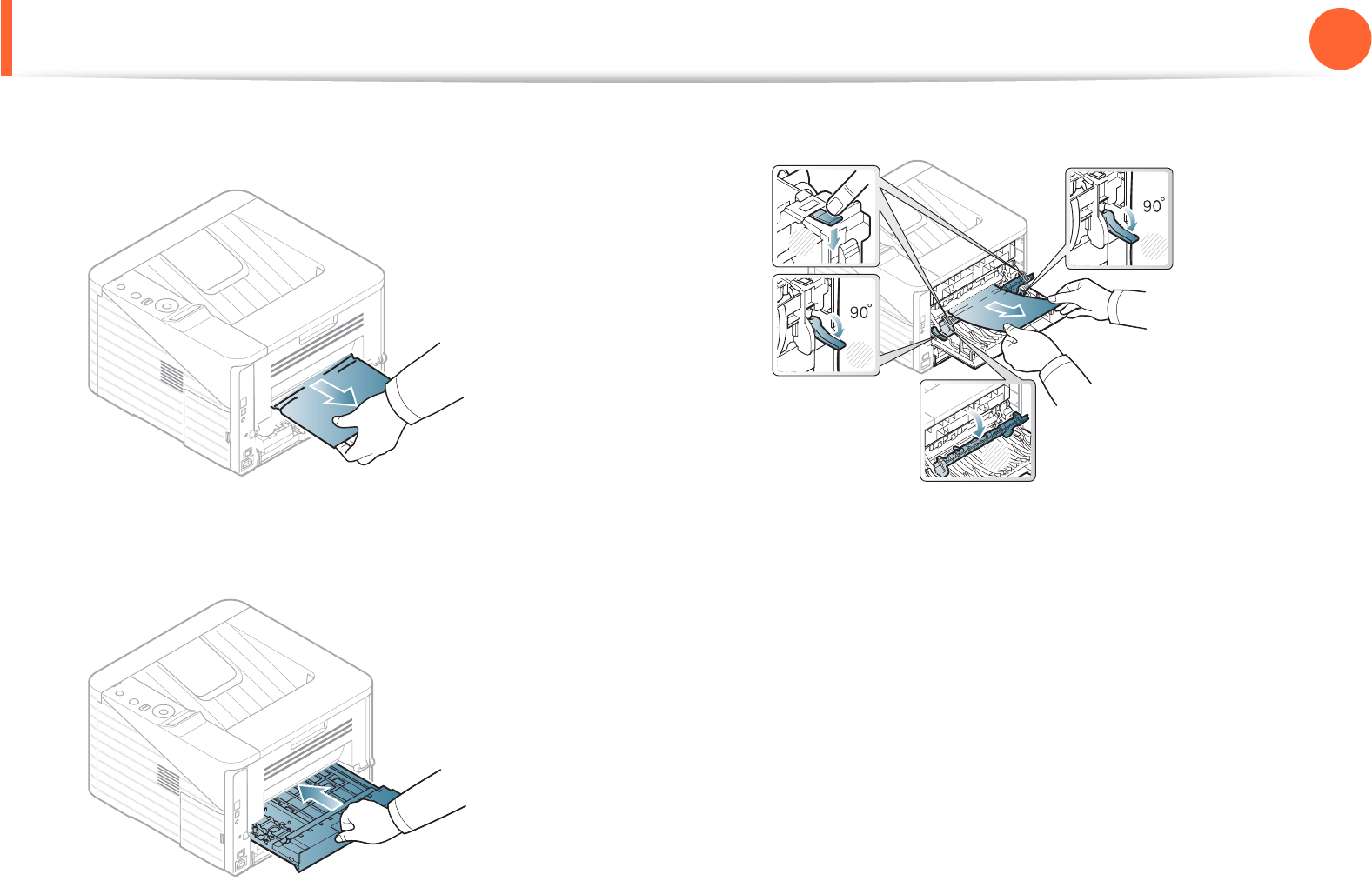
Clearing paper jams 71
4. Troubleshooting
If the paper does not come out with the duplex unit, remove
the paper from the bottom of the machine.
If you still do not see the paper, go to the next step.
3 Insert the duplex unit into the machine.
4 Open the rear cover.
5 Remove the jammed paper as shown in the following figure.
6 Close the rear cover. Printing automatically resumes.
3
1
1
3
2

72
4. Troubleshooting
Understanding the status LED
The color of the LED indicates the machine's current status.
• Some LEDs may not be available depending on model or country.
• To resolve the error, look at the error message and its instructions from the troubleshooting part.
• You also can resolve the error with the guideline from the computers’s Samsung Printer Status or Smart Panel program window.
• If the problem persists, call a service representative.
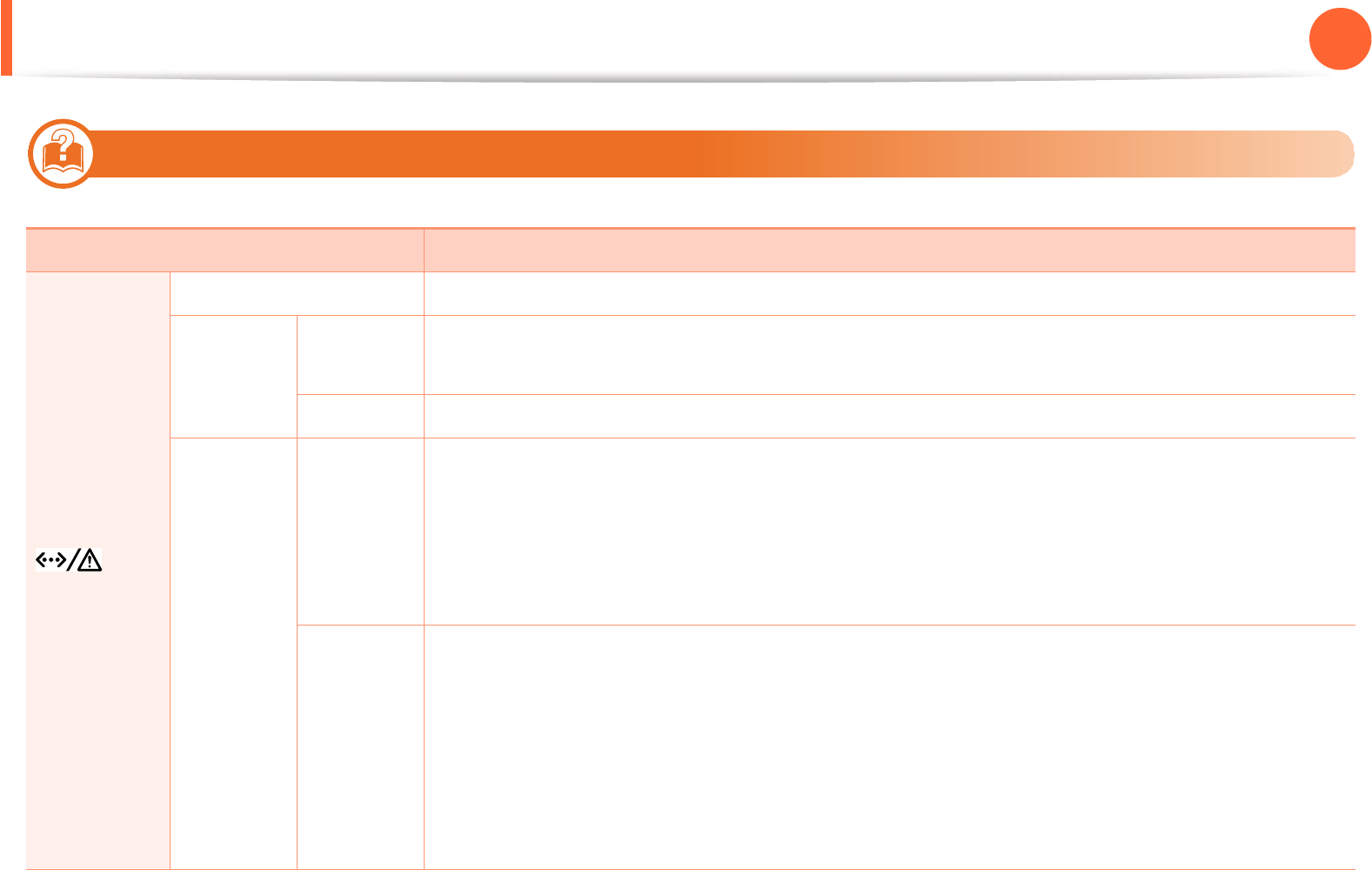
Understanding the status LED 73
4. Troubleshooting
7
Status LED
Status Description
(Status LED)
Off The machine is off-line.
Green Blinking • When the backlight slowly blinks, the machine is receiving data from the computer.
• When the backlight blinks rapidly, the machine is printing data.
On • The machine is on-line and can be used.
Red
Blinking
• A minor error has occurred and the machine is waiting for the error to be cleared. Check the display
message. When the problem is cleared, the machine resumes. For some models that does not
support the display screen on the control panel, this feature is not applicable.
• Small amount of toner is left in the cartridge. The estimated cartridge life of toner is close. Prepare
a new cartridge for replacement. You may temporarily increase the printing quality by
redistributing the toner (see "Redistributing toner" on page 52).
On
• A toner cartridge has almost reached its estimated cartridge lifea. It is recommended to replace the
toner cartridge (see "Replacing the toner cartridge" on page 54).
• The cover is opened. Close the cover.
• There is no paper in the tray. Load paper in the tray.
• The machine has stopped due to a major error. Check the display message (see "Understanding
display messages" on page 75).
• A paper jam has occurred (see "Clearing paper jams" on page 66).
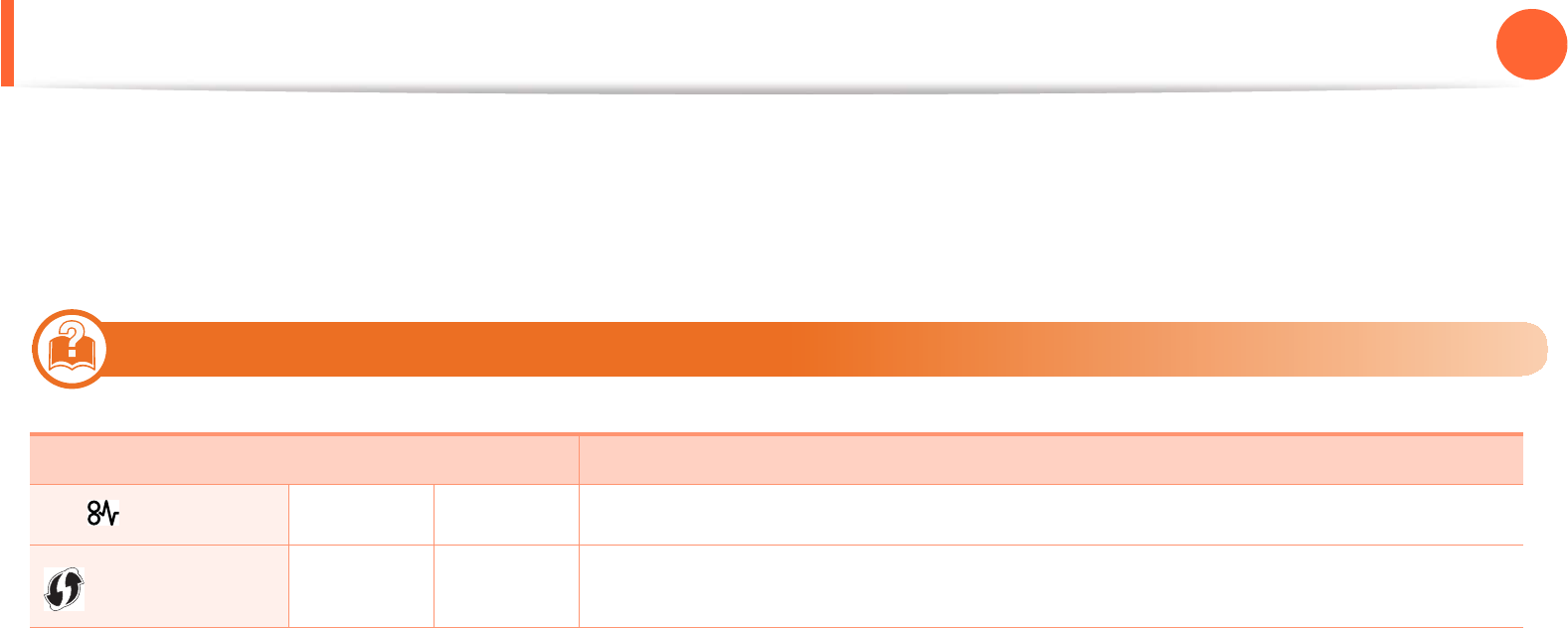
Understanding the status LED 74
4. Troubleshooting
8
Jam LED/ WPS LED
a. Estimated cartridge life means the expected or estimated toner cartridge life, which indicates the average capacity of print-outs and is designed pursuant to ISO/
IEC 19752. The number of pages may be affected by operating environment, printing interval, graphics, media type and media size. Some amount of toner may
remain in the cartridge even when red LED is on and the printer stops printing.
Status Description
(Jam LED) Orange On A paper jam has occurred (see "Clearing paper jams" on page 66).
(WPS LED) Blue On When the machine is connected to a wireless network, WPS LED lights on blue (see
Advanced Guide).
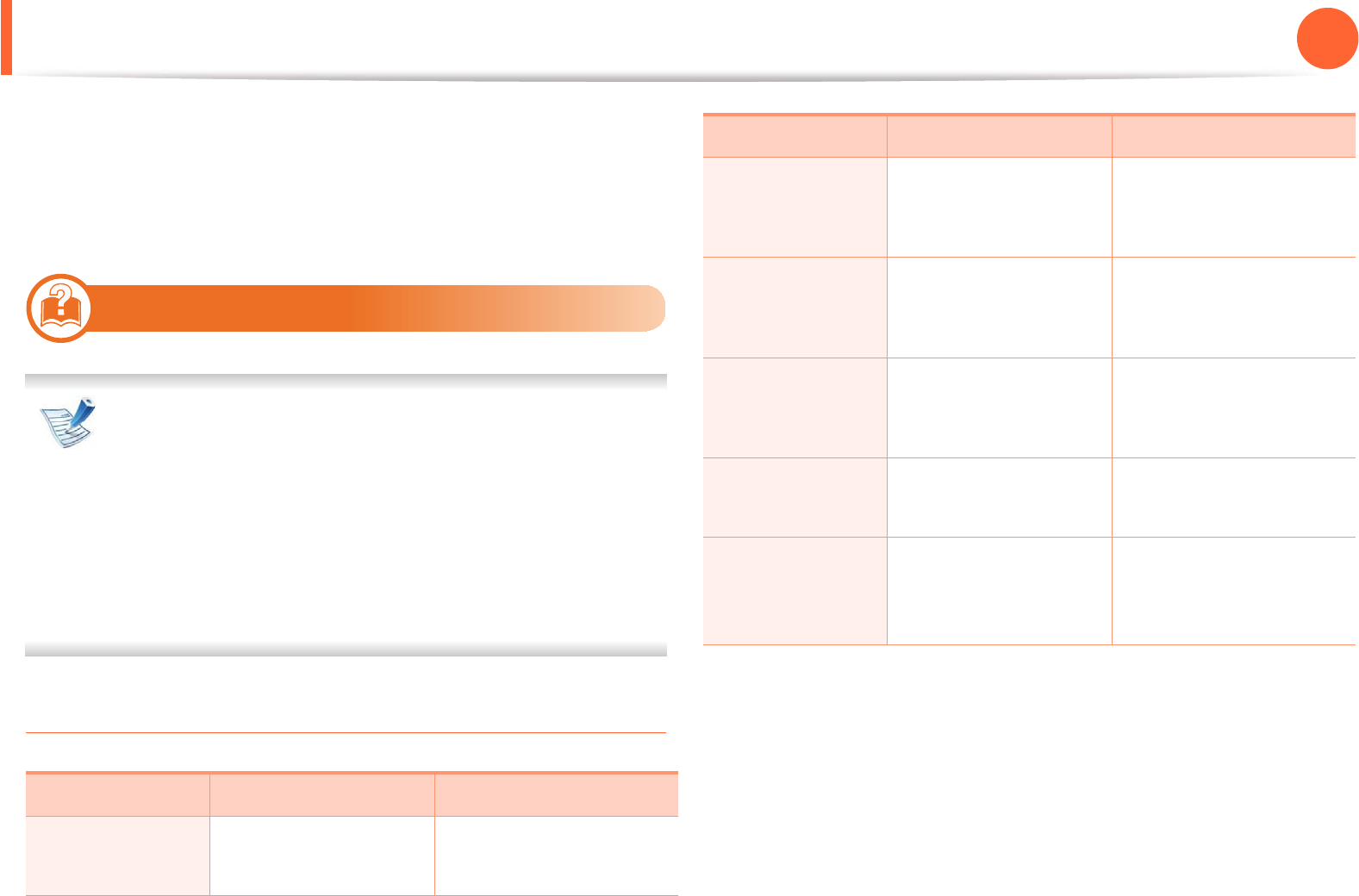
75
4. Troubleshooting
Understanding display messages
Messages appear on the control panel display to indicate the
machine’s status or errors. Refer to the tables below to understand
the messages’ and their meaning, and correct the problem, if
necessary.
9
Checking display messages
• If a message is not in the table, reboot the power and try
the printing job again. If the problem persists, call a service
representative.
• When you call for service, provide the service
representative with the contents of display message.
• Some messages may not appear on the display depending
on the options or models.
• [error number] indicates the error number.
Paper Jam-related messages
Message Meaning Suggested solutions
Paper Jam
in Tray 1
Paper has jammed in
the paper feed area.
Clear the jam (see "In tray
1" on page 66).
Paper Jam
in Tray 2
Paper has jammed in
the optional tray.
Clear the jam (see "In
optional tray2" on page
67).
Paper Jam
in MP tray
Paper has jammed in
the multi-purpose tray.
Clear the jam (see "In the
multi-purpose tray" on
page 68).
Paper Jam
inside machine
Paper has jammed in
the inside machine.
Clear the jam (see "Inside
the machine" on page
68).
Paper Jam
in exit area
Paper has jammed in
the paper exit area.
Clear the jam (see "In the
exit area" on page 69).
Paper Jam
bottom of
duplex
Paper has jammed in
the duplex area.
Clear the jam (see "In the
duplex unit area" on
page 70).
Message Meaning Suggested solutions

Understanding display messages 76
4. Troubleshooting
Toner-related messages
Message Meaning Suggested solutions
Install Toner A toner cartridge is not installed. Install a toner cartridge.
Not
Compatible
Toner
cartridge
The toner cartridge you have installed is not for
your machine.
Install a Samsung-genuine toner cartridge, designed for your machine.
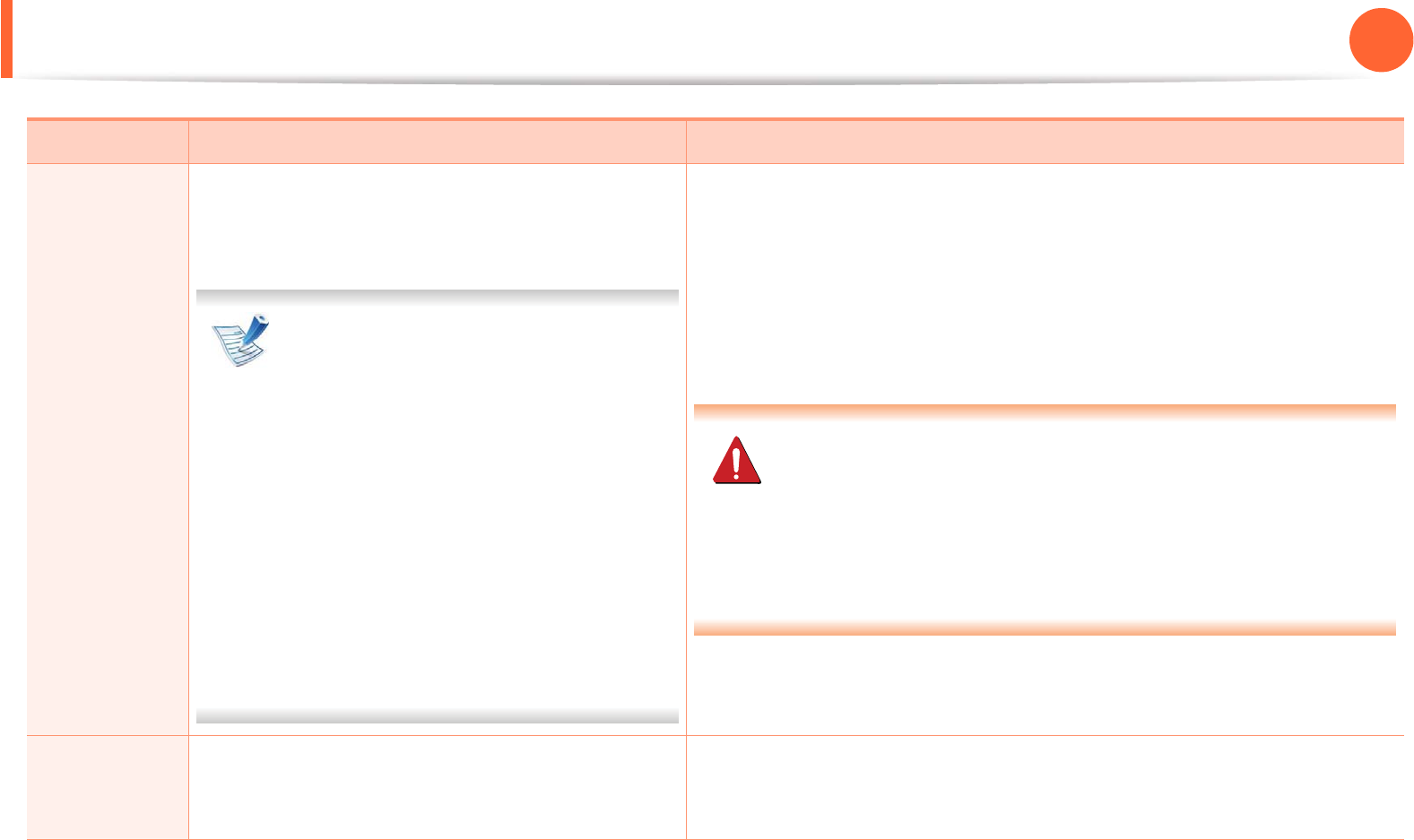
Understanding display messages 77
4. Troubleshooting
Replace new
cartridge
The indicated toner cartridge has almost reached
its estimated cartridge life. The machine might stop
printing.
Estimated cartridge life means the
expected or estimated toner cartridge
life, which indicates the average capacity
of print-outs and is designed pursuant to
ISO/IEC 19752 (see "Available supplies"
on page 49). The number of pages may
be affected by operating environment,
printing interval, media type, percentage
of image area, and media size. Some
amount of toner may remain in the
cartridge even when replace new
cartridge appears and the machine stops
printing.
•You can choose Stop or Continue as shown on the control panel. If you
select Stop, the printer stops printing and you cannot print any more
without changing the cartridge. If you select Continue, the printer
keeps printing but the printing quality cannot be guaranteed.
• Replace the toner cartridge for the best print quality when this message
appears. Using a cartridge beyond this stage can result in printing
quality issues (see "Replacing the toner cartridge" on page 54).
Samsung does not recommend using non-genuine Samsung
toner cartridge such as refilled or remanufactured. Samsung
cannot guarantee non-genuine Samsung toner cartridge's
quality. Service or repair required as a result of using non-
genuine Samsung toner cartridges will not be covered under the
machine warranty.
• If the machine stops printing, replace the toner cartridge (See
"Replacing the toner cartridge" on page 54).
Prepare new
cartridge
Small amount of toner is left in the indicated
cartridge. The estimated cartridge life of toner is
close.
Prepare a new cartridge for a replacement. You may temporarily increase
the printing quality by redistributing the toner (see "Redistributing toner"
on page 52).
Message Meaning Suggested solutions
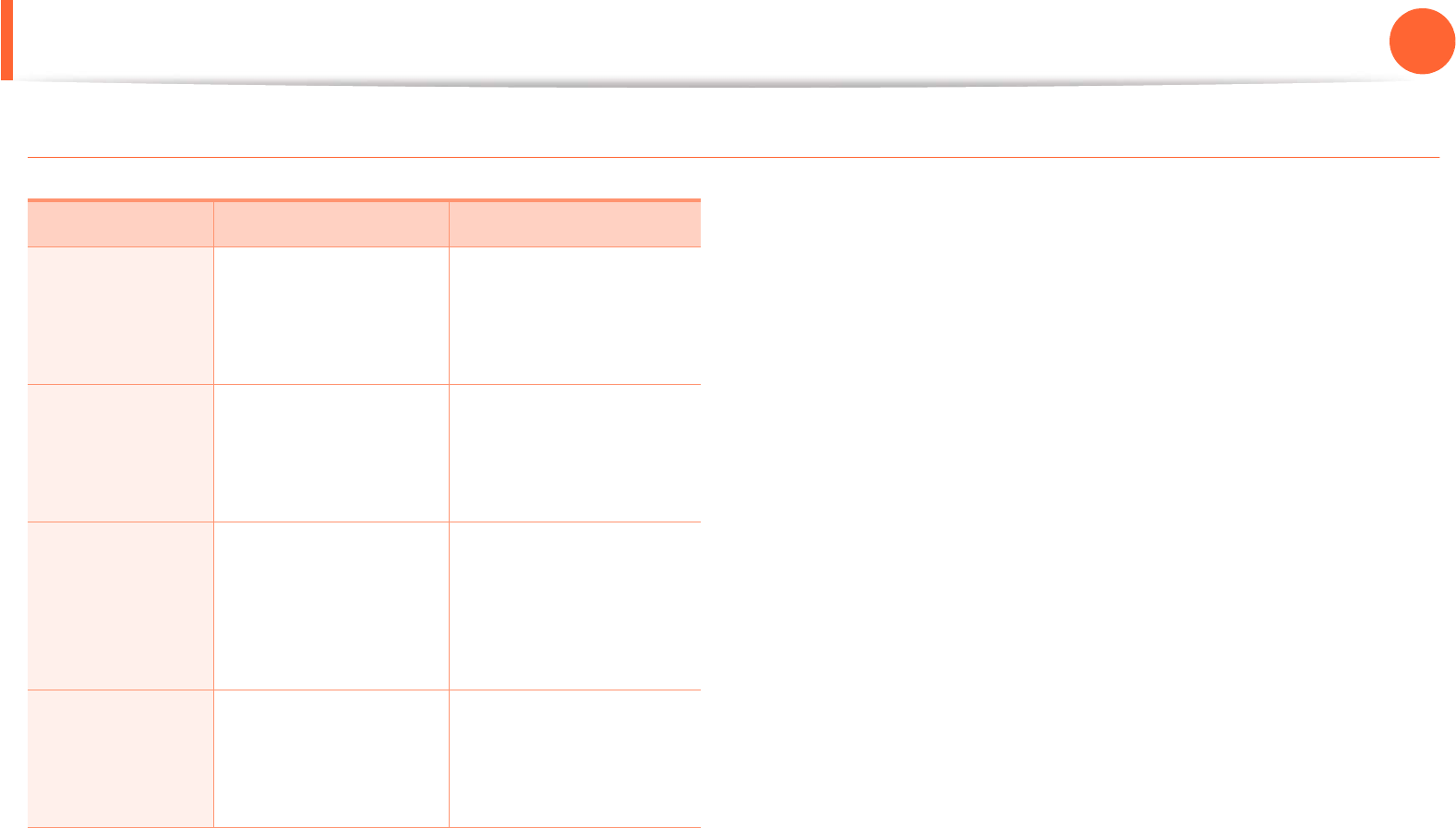
Understanding display messages 78
4. Troubleshooting
Tray-related messages
Message Meaning Suggested solutions
Paper Empty
in Tray 1
There is no paper in
tray 1.
Load paper in tray 1 (see
"Loading paper in the
tray/ optional tray" on
page 31).
Paper Empty
in Tray 2
There is no paper in
tray 2.
Load paper in tray 2 (see
"Loading paper in the
tray/ optional tray" on
page 31).
Paper Empty
in MP tray
There is no paper in
the multi-purpose
tray.
Load paper in the multi-
purpose tray (see
"Loading in multi-
purpose tray" on page
33).
Output bin full
Remove paper
The output tray is full. Remove papers from
the output tray, the
printer resumes
printing.

Understanding display messages 79
4. Troubleshooting
Network-related messages
Misc. messages
Message Meaning Suggested solutions
Network
Problem
IP Conflict
The network IP
address you have set is
being used by
someone else.
Check the IP address and
reset it if necessary (see
Advanced Guide).
802.1x
Network Error
Fail to authenticate. Check the network
authentication protocol.
If the problem persists,
contact your network
administrator.
Message Meaning Suggested solutions
Door Open
Close it
The front cover or rear
cover is not securely
latched.
Close the cover until it
locks into place.
Error [error
number]
Call for service
A system error has
occurred
Reboot the power and
try the printing job
again. If the problem
persists, please call for
service.
Error [error
number]
Turn off then on
The machine unit
cannot be controlled.
Reboot the power and
try the printing job
again. If the problem
persists, please call for
service.
Message Meaning Suggested solutions

5. Appendix
This chapter provides product specifications and information concerning
applicable regulations.
•Specifications 81
• Regulatory information 91
• Copyright 101
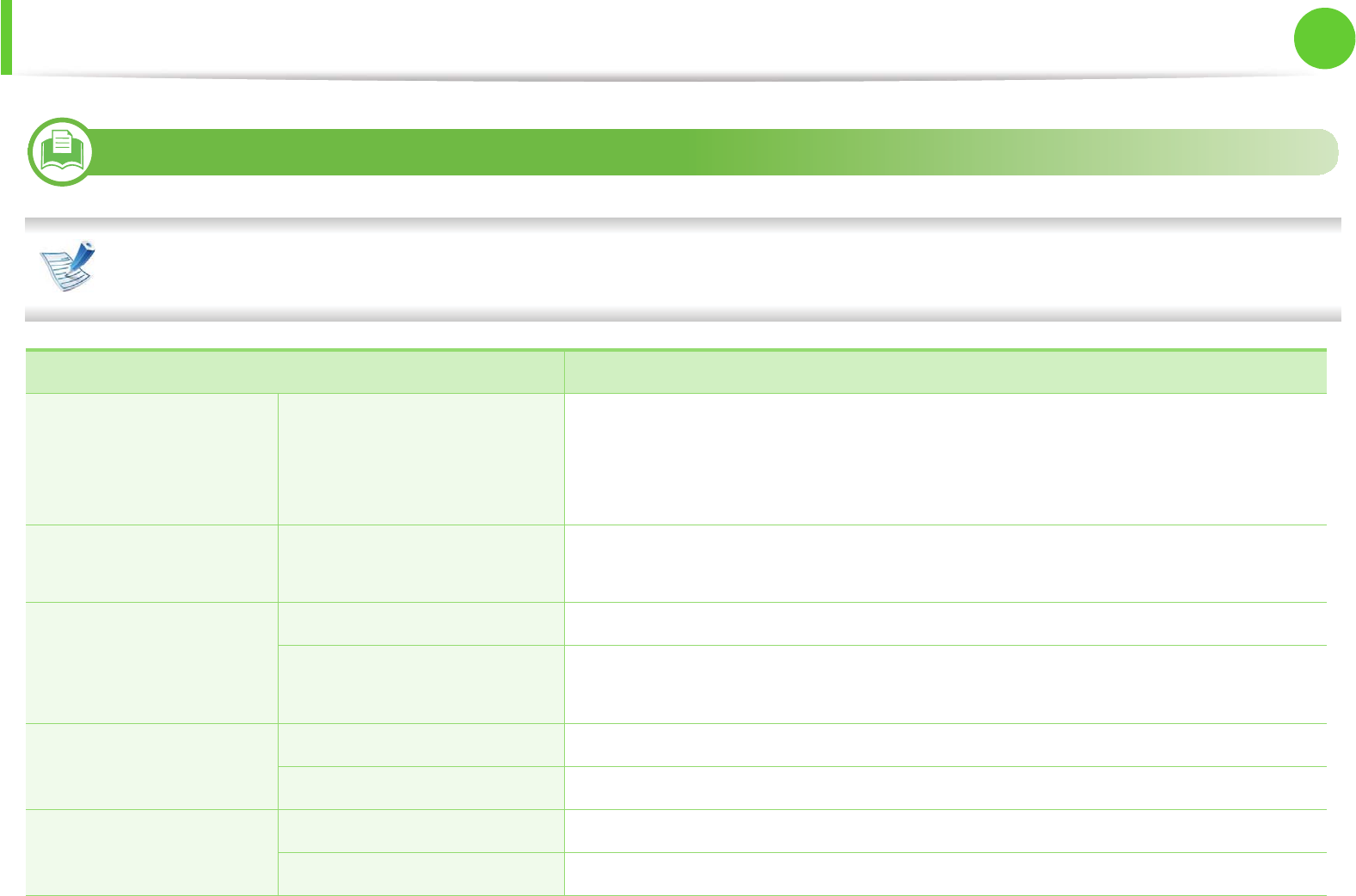
81
5. Appendix
Specifications
1
General specifications
The specification values listed below are subject to change without notice. See www.samsung.com/printer for possible changes in
information.
Items Description
Dimension Width x Length x Height
•ML-331xD: 366 x 368 x 240.6 mm (14.40 x 14.48 x 9.47 inches) without optional
tray
•ML-331xND/ML-371xD/ML-371xND/ML-371xDW: 366 x 368 x 252.9 mm
(14.40 x 14.48 x 9.96 inches) without optional tray
Weight Machine with consumables •ML-331x Series: 9.74 kg (21.47 lbs)
•ML-371x Series: 9.95 kg (21.94 lbs)
Noise Levela
Ready mode 26 dB (A)
Print mode •ML-331x Series: 51 dB (A)
•ML-371x Series: 52 dB (A)
Temperature Operation 10 to 32°C (50 to 90°F)
Storage (packed) -20 to 40°C (-4 to 104°F)
Humidity Operation 20 to 80% RH
Storage (packed) 10 to 90% RH

Specifications 82
5. Appendix
Power ratingb110 volt models AC 110 - 127 V
220 volt models AC 220 - 240 V
Power consumption Average operating mode Less than 550 W
Ready mode Less than 60 W
Power save mode Less than 3.5 W
Power off mode Less than 0.4 W (0.1 Wc)
Wireless dModule U98Z058
a. Sound Pressure Level, ISO 7779. Configuration tested: basic machine installation, A4 paper, simplex printing.
b. See the rating label on the machine for the correct voltage (V), frequency (hertz) and type of current (A) for your machine.
c. For the machine that has a power switch.
d. Wireless model only (see "Features by models" on page 7).
Items Description
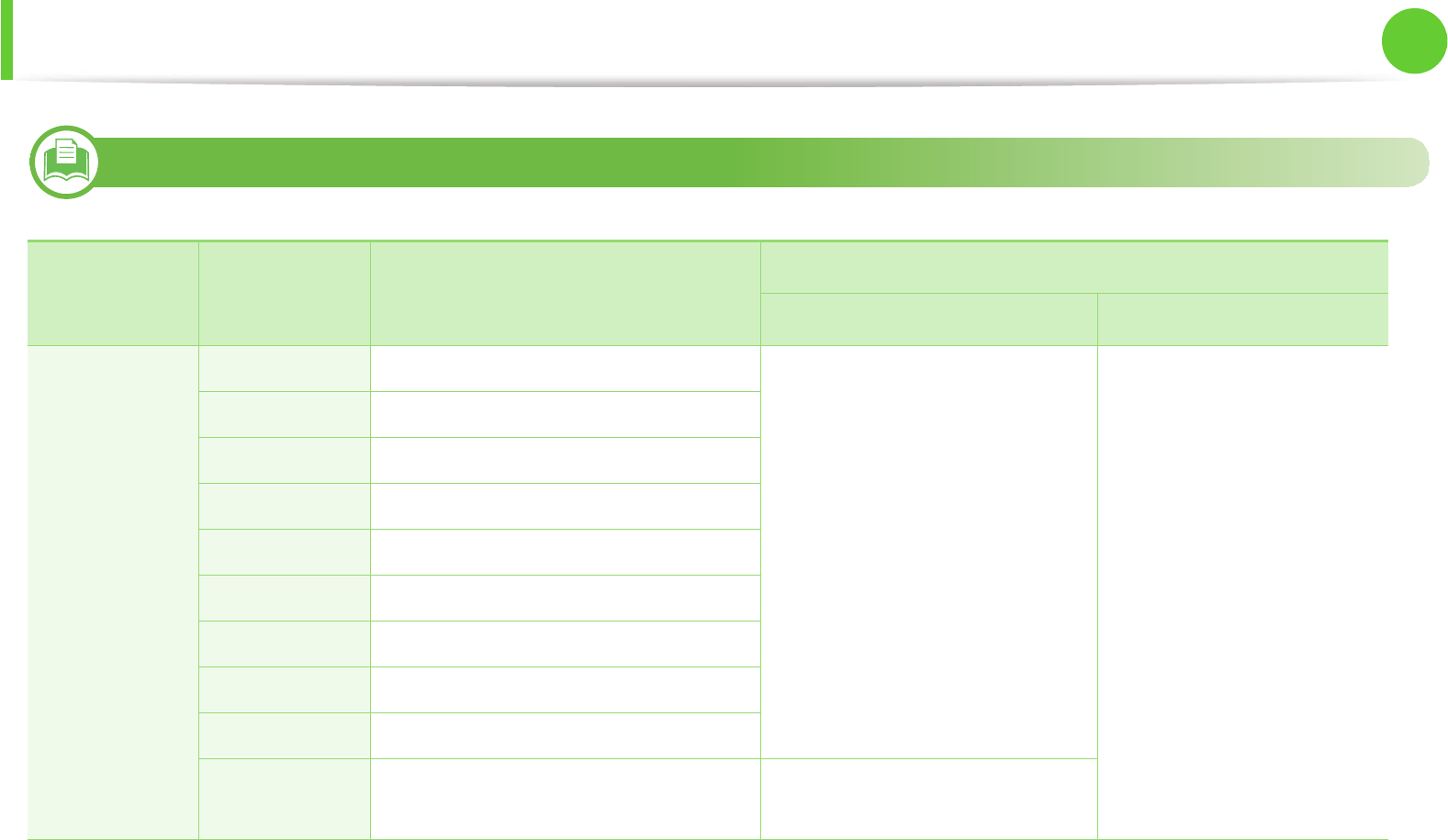
Specifications 83
5. Appendix
2
Print media specifications
Type Size Dimensions Print media weight/Capacitya
Tray1 / Optional tray Multi-purpose trayb
Plain paper
Letter 216 x 279 mm (8.5 x 11 inches) 70 to 90 g/m2 (19 to 24 lbs bond)
• 250 sheets of 80 g/m2 (20 lbs
bond) for tray1.
• 520 sheets of 80 g/m2 (20 lbs
bond) for optional tray.
70 to 90 g/m2 (19 to 24 lbs
bond)
• The machine does not
have a display screen: 1
sheet of 80 g/m2 (20 lbs
bond)
• The machine has a display
screen: 50 sheets of 80 g/
m2 (20 lb bond)
Legal 216 x 356 mm (8.5 x 14 inches)
US Folio 216 x 330 mm (8.5 x 13 inches)
A4 210 x 297 mm (8.27 x 11.69 inches)
Oficio 216 x 343 mm (8.5 x 13.5 inches)
JIS B5 182 x 257 mm (7.17 x 10.12 inches)
ISO B5 176 x 250 mm (6.93 x 9.84 inches)
Executive 184 x 267 mm (7.25 x 10.5 inches)
A5 148 x 210 mm (5.83 x 8.27 inches)
A6 105 x 148 mm (4.13 x 5.83 inches) • 150 sheets of 75 g/m2 (20 lbs
bond)
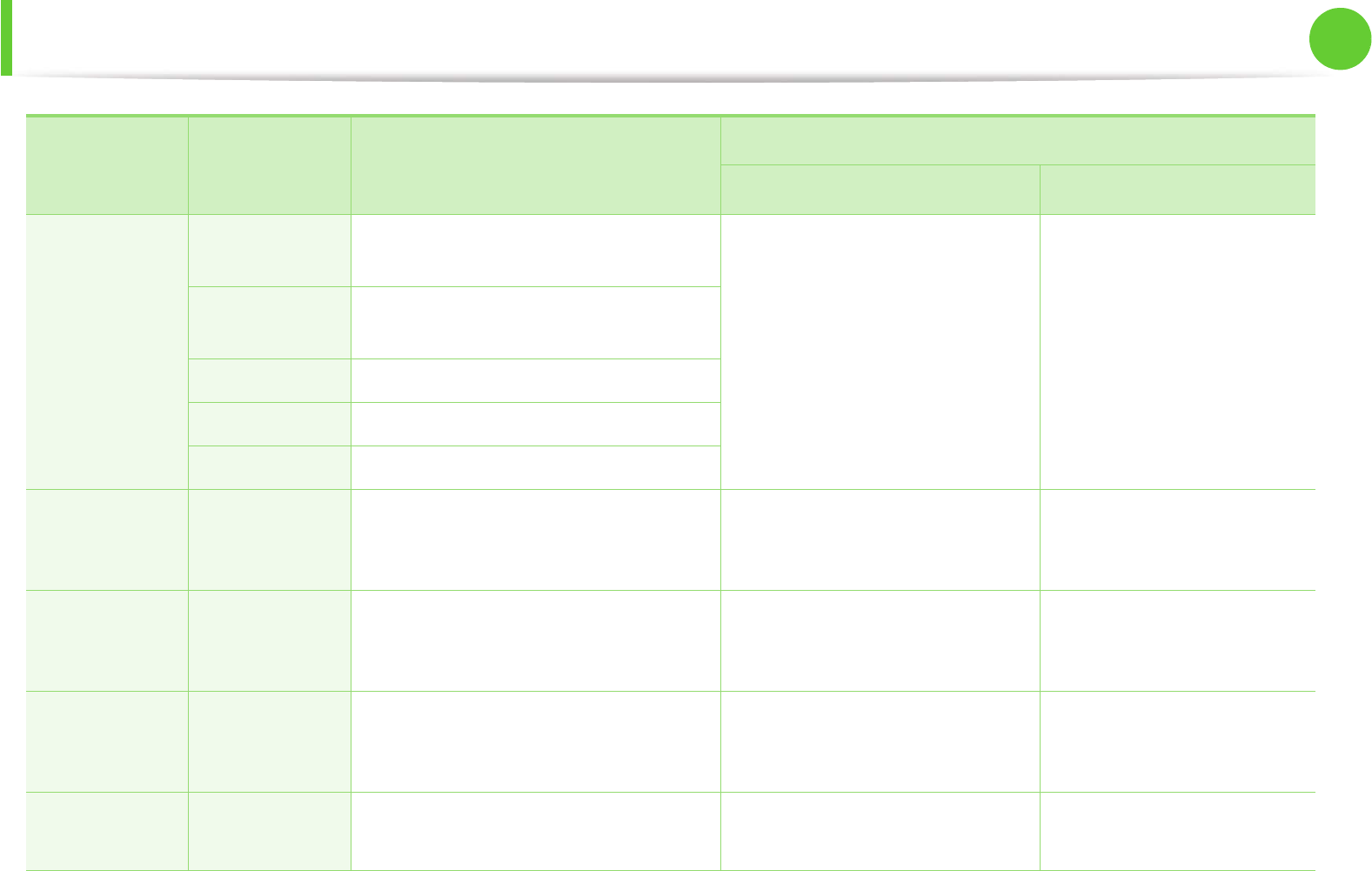
Specifications 84
5. Appendix
Envelope
Envelope
Monarch
98 x 191 mm (3.87 x 7.5 inches) Not available in tray1/optional
tray.
75 to 90 g/m2 (20 to 24 lbs
bond)
Envelope No.
10
105 x 241 mm (4.12 x 9.5 inches)
Envelope DL 110 x 220 mm (4.33 x 8.66 inches)
Envelope C5 162 x 229 mm (6.38 x 9.02 inches)
Envelope C6 114 x 162 mm (4.49 x 6.38 inches)
Thick paper
Refer to the
Plain paper
section
Refer to the Plain paper section 91 to 105 g/m2 (24 to 28 lbs
bond)
91 to 105 g/m2 (24 to 28 lbs
bond)
Thicker paper
Refer to the
Plain paper
section
Refer to the Plain paper section Not available in tray1/optional
tray.
164 to 220 g/m2 (44 to 58 lbs
bond)
Thin paper
Refer to the
Plain paper
section
Refer to the Plain paper section 60 to 70 g/m2 (16 to 19 lbs bond) 60 to 70 g/m2 (16 to 19 lbs
bond)
Transparency Letter, A4 Refer to the Plain paper section Not available in tray1/optional
tray.
138 to 146 g/m2 (36.81 to
38.91 lbs bond)
Type Size Dimensions Print media weight/Capacitya
Tray1 / Optional tray Multi-purpose trayb
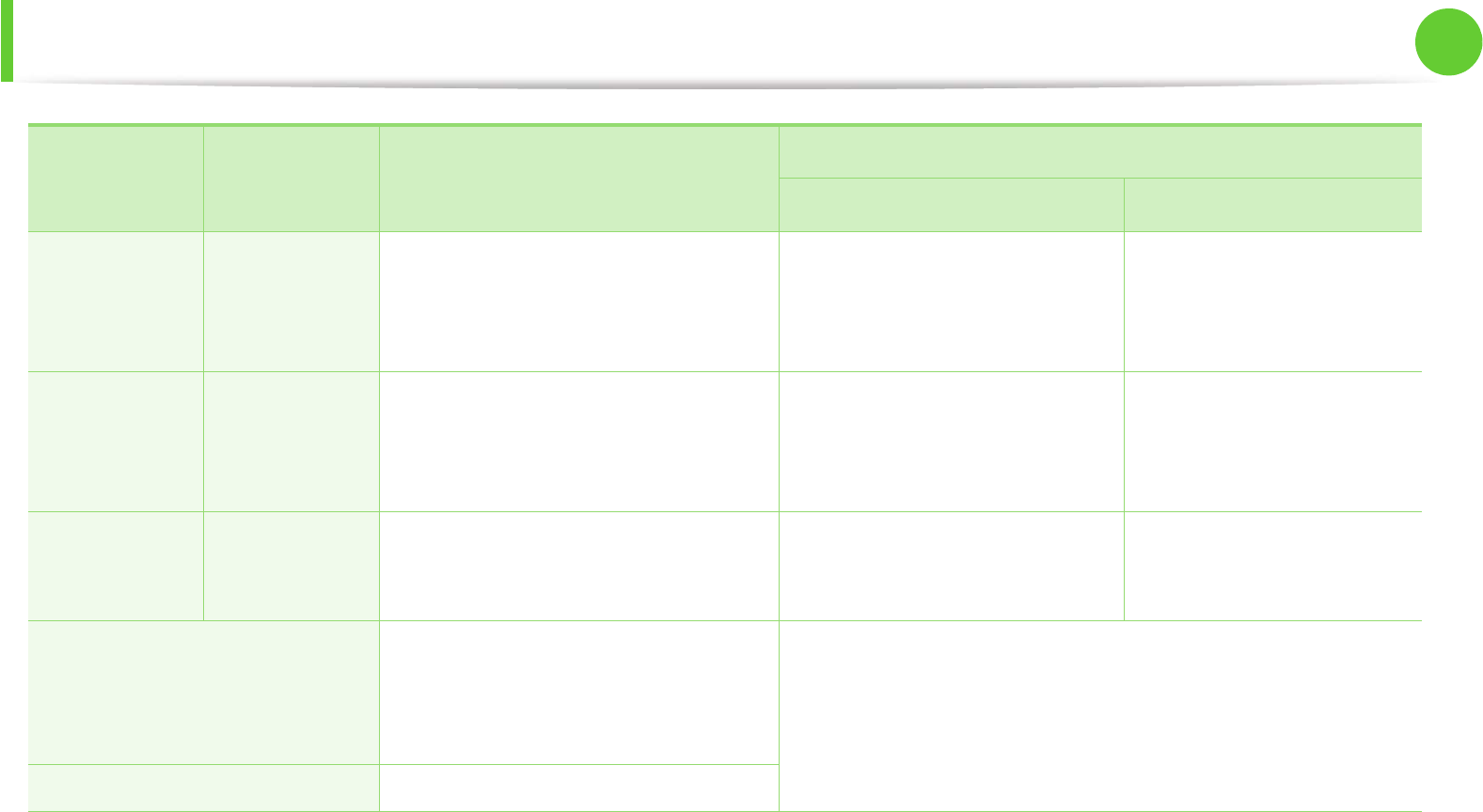
Specifications 85
5. Appendix
Labelsc
Letter, Legal,
US Folio, A4,
JIS B5, ISO B5,
Executive, A5
Refer to the Plain paper section Not available in tray1/optional
tray.
120 to 150 g/m2 (32 to 40 lbs
bond)
Card stock
Letter, Legal,
US Folio, A4,
JIS B5, ISO B5,
Executive, A5
Refer to the Plain paper section 121 to 163 g/m2 ( 32 to 43 lbs
bond)
121 to 163 g/m2 (32 to 43 lbs
bond)
Bond paper
Refer to the
Plain paper
section
Refer to the Plain paper section 106 to 120 g/m2 (28 to 32 lbs
bond)
106 to 120 g/m2 (28 to 32 lbs
bond)
Minimum size (custom)
•Multi-purpose tray: 76 x 127 mm (3
x 5 inches)
•Tray 1: 105 x 148.5 mm (4.13 x 5.85
inches)
60 to 163 g/m2 (16 to 43 lbs bond) d, e
Not available in optional tray.
Maximum size (custom) 216 x 356 mm (8.5 x 14 inches)
a. Maximum capacity may differ depending on media weight, thickness, and environmental conditions.
b. The machine does not have a display screen: 1 sheet for multi-purpose tray.
c. The smoothness of the labels used in this machine is 100 to 250 (sheffield). This means the numeric level of smoothness.
d. The paper types available in multi-purpose tray: Plan, Thick, Thicker, Thin, Cotton, Colored, Pre-printed, Recycled, Envelope, Transparency, Labels, Cardstock,
Bond, Archive
e. The paper types available in tray 1: Plan, Thick, Thin, Recycled, Cardstock, Bond, Archive
Type Size Dimensions Print media weight/Capacitya
Tray1 / Optional tray Multi-purpose trayb
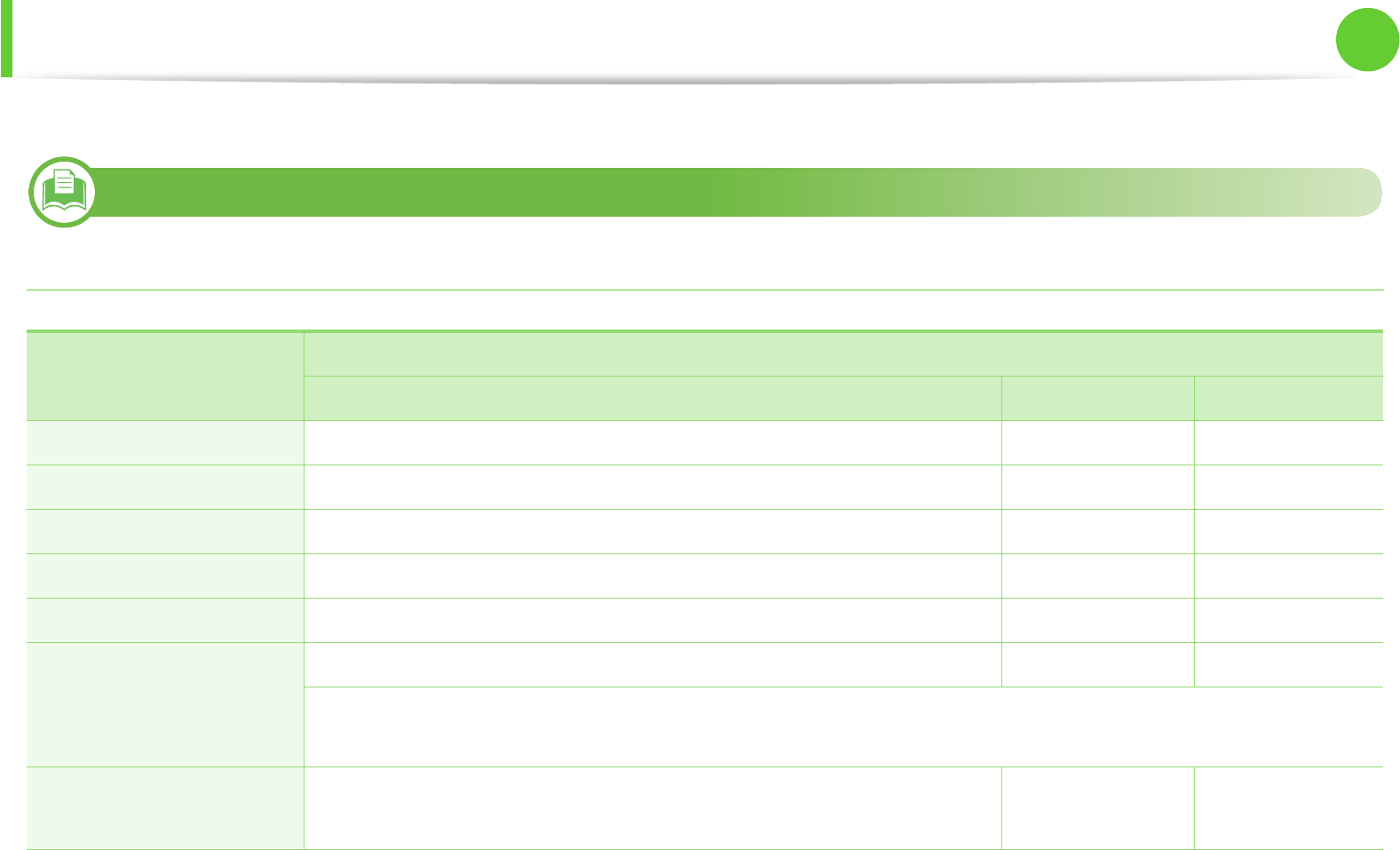
Specifications 86
5. Appendix
3
System requirements
Microsoft® Windows®
Operating system Requirement (recommended)
CPU RAM free HDD space
Windows® 2000 Intel® Pentium® II 400 MHz (Pentium III 933 MHz) 64 MB (128 MB) 600 MB
Windows® XP Intel® Pentium® III 933 MHz (Pentium IV 1 GHz) 128 MB (256 MB) 1.5 GB
Windows Server® 2003 Intel® Pentium® III 933 MHz (Pentium IV 1 GHz) 128 MB (512 MB) 1.25 GB to 2 GB
Windows Server® 2008 Intel® Pentium® IV 1 GHz (Pentium IV 2 GHz) 512 MB (2 GB) 10 GB
Windows Vista® Intel® Pentium® IV 3 GHz 512 MB (1 GB) 15 GB
Windows® 7 Intel® Pentium® IV 1 GHz 32-bit or 64-bit processor or higher 1 GB (2 GB) 16 GB
• Support for DirectX® 9 graphics with 128 MB memory (to enable the Aero theme).
•DVD-R/W Drive
Windows Server® 2008 R2 Intel® Pentium® IV 1 GHz (x86) or 1.4 GHz (x64) processors (2 GHz or faster) 512 MB (2 GB) 10 GB
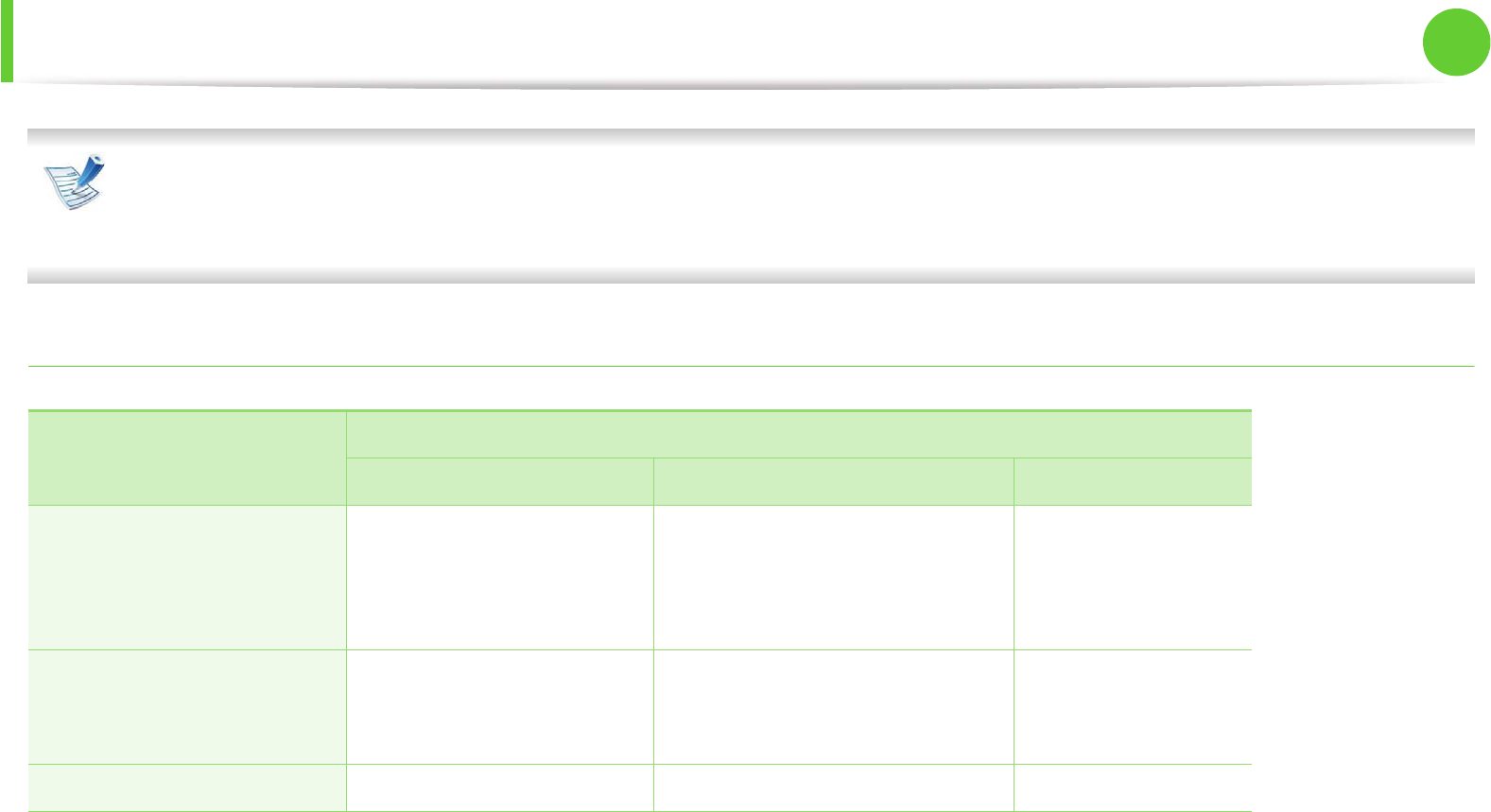
Specifications 87
5. Appendix
• Internet Explorer 5.0 or higher is the minimum requirement for all Windows operating systems.
• Users who have administrator rights can install the software.
•Windows Terminal Services is compatible with your machine.
Macintosh
Operating system Requirements (Recommended)
CPU RAM Free HDD space
Mac OS X 10.3 ~ 10.4
• Intel® processors
• PowerPC G4/ G5
• 128 MB for a powerPC based
Mac (512 MB)
• 512 MB for an Intel-based Mac
(1 GB)
1 GB
Mac OS X 10.5
• Intel® processors
• 867 MHz or faster Power
PC G4/ G5
512 MB (1 GB) 1 GB
Mac OS X 10.6 • Intel® processors 1 GB (2 GB) 1 GB
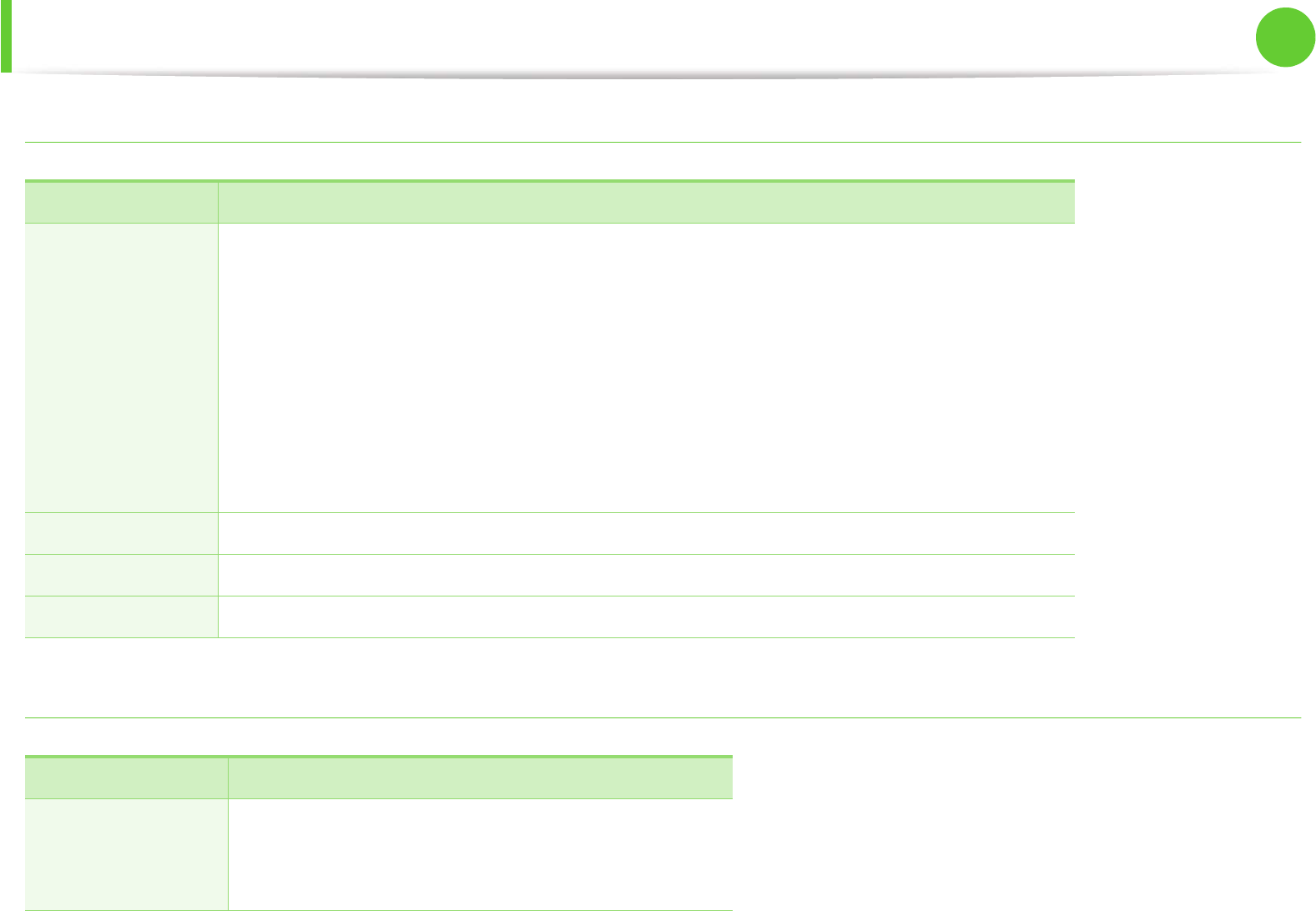
Specifications 88
5. Appendix
Linux
Unix
Items Requirements
Operating system
Fedora 4 ~ 12 (32/ 64 bit)
OpenSuSE® 10.2, 10.3, 11.0, 11.1, 11.2 (32/64 bit)
SuSE 10.0, 10.1 (32 bit)
Ubuntu 5.04, 5.10, 6.04, 6.10, 7.04, 7.10, 8.04, 8.10, 9.04, 9.10 (32/64 bit)
Mandriva 2005, 2006, 2007, 2008, 2009, 2009.1 (32/64 bit)
Debian 4.0, 5.0 (32/64 bit)
Redhat® Enterprise Linux WS 4, 5 (32/64 bit)
SuSE Linux Enterprise Desktop 10, 11 (32/64 bit)
CPU Pentium IV 2.4GHz (Intel Core™2)
RAM 512 MB (1 GB)
Free HDD space 1 GB (2 GB)
Items Requirements
Operating system
Sun Solaris 9, 10 (x86, SPARC)
HP-UX 11.0, 11i v1, 11i v2, 11i v3 (PA-RISC, Itanium)
IBM AIX 5.1, 5.2, 5,3, 5.4
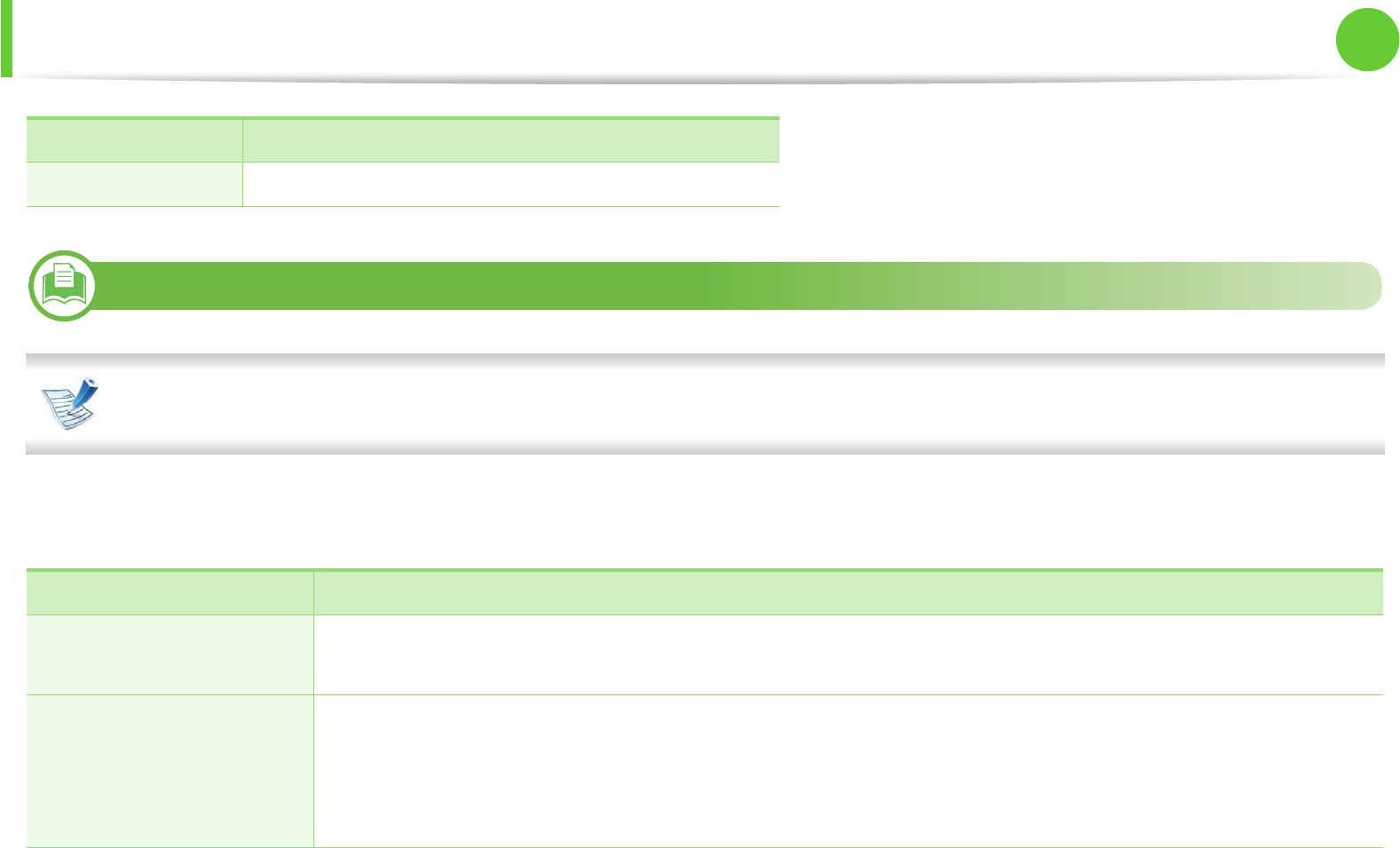
Specifications 89
5. Appendix
4
Network environment
Network and wireless models only (see "Features by models" on page 7)
You need to set up the network protocols on the machine to use it as your network machine. The following table shows the network
environments supported by the machine.
Free HDD space Up to 100 MB
Items Specifications
Network interface • Ethernet 10/100/1000 Base-TX
• 802.11b/g/n Wireless LAN
Network operating system
• Windows 2000/Server 2003 /Server 2008/XP/Vista/7/Server 2008 R2
•Various Linux OS
• Mac OS X 10.3 ~ 10.6
•Unix
Items Requirements
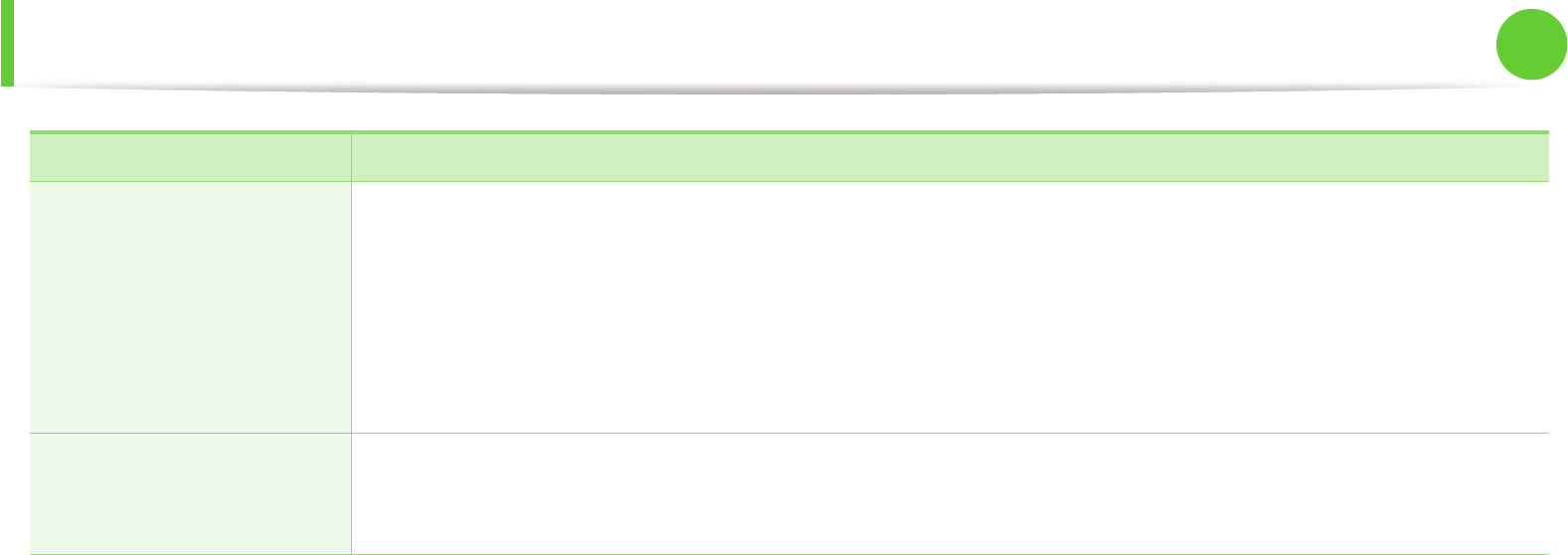
Specifications 90
5. Appendix
Network protocols
•TCP/IPv4
• DHCP, BOOTP
• DNS, WINS, Bonjour, SLP, UPnP
• Standard TCP/IP Printing (RAW), LPR, IPP, WSD
• SNMPv 1/2/3, HTTP (S), IPSec
• TCP/IPv6 (DHCP, DNS, RAW, LPR, SNMPv 1/2/3, HTTP (S), IPSec)
Wireless security
• Authentication: Open System, Shared Key, WPA Personal, WPA2 Personal (PSK), WPA Enterprise, WPA2
Enterprise
• Encryption: WEP64, WEP128, TKIP, AES
Items Specifications
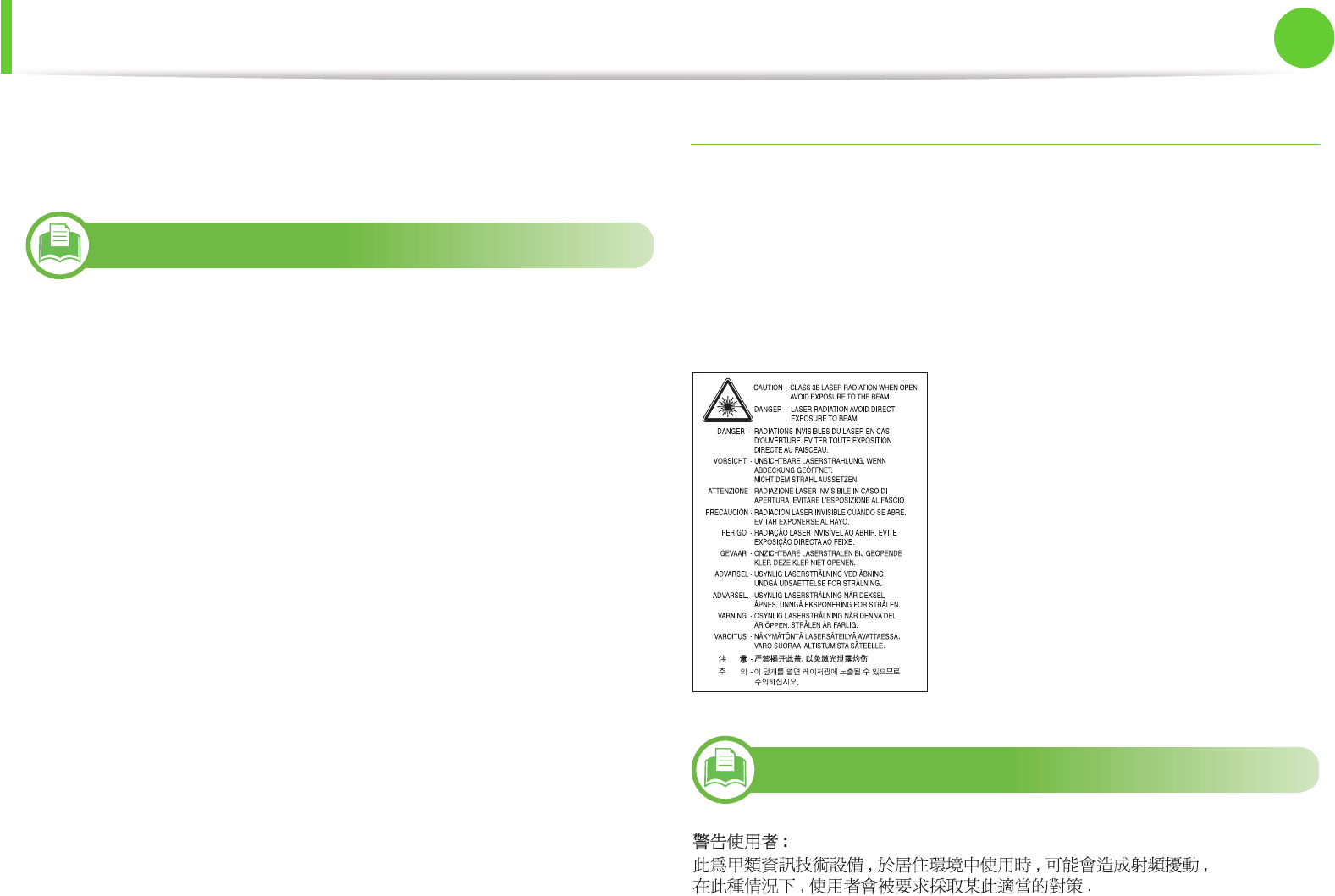
91
5. Appendix
Regulatory information
This machine is designed for a normal work environment and
certified with several regulatory statements.
5
Laser safety statement
The printer is certified in the U.S. to conform to the requirements of
DHHS 21 CFR, chapter 1 Subchapter J for Class I(1) laser products,
and elsewhere is certified as a Class I laser product conforming to the
requirements of IEC 60825-1 : 2007.
Class I laser products are not considered to be hazardous. The laser
system and printer are designed so there is never any human access
to laser radiation above a Class I level during normal operation, user
maintenance or prescribed service condition.
•Wavelength: 800 nm
•Beam divergence
-Paraller: 12 degrees
-Perpendicular: 35 degrees
•Maximum power or energy output: 15 mW
Warning
Never operate or service the printer with the protective cover
removed from laser/scanner assembly. The reflected beam,
although invisible, can damage your eyes.
When using this product, these basic safety precautions should
always be followed to reduce risk of fire, electric shock, and injury to
persons:
6
Taiwan only
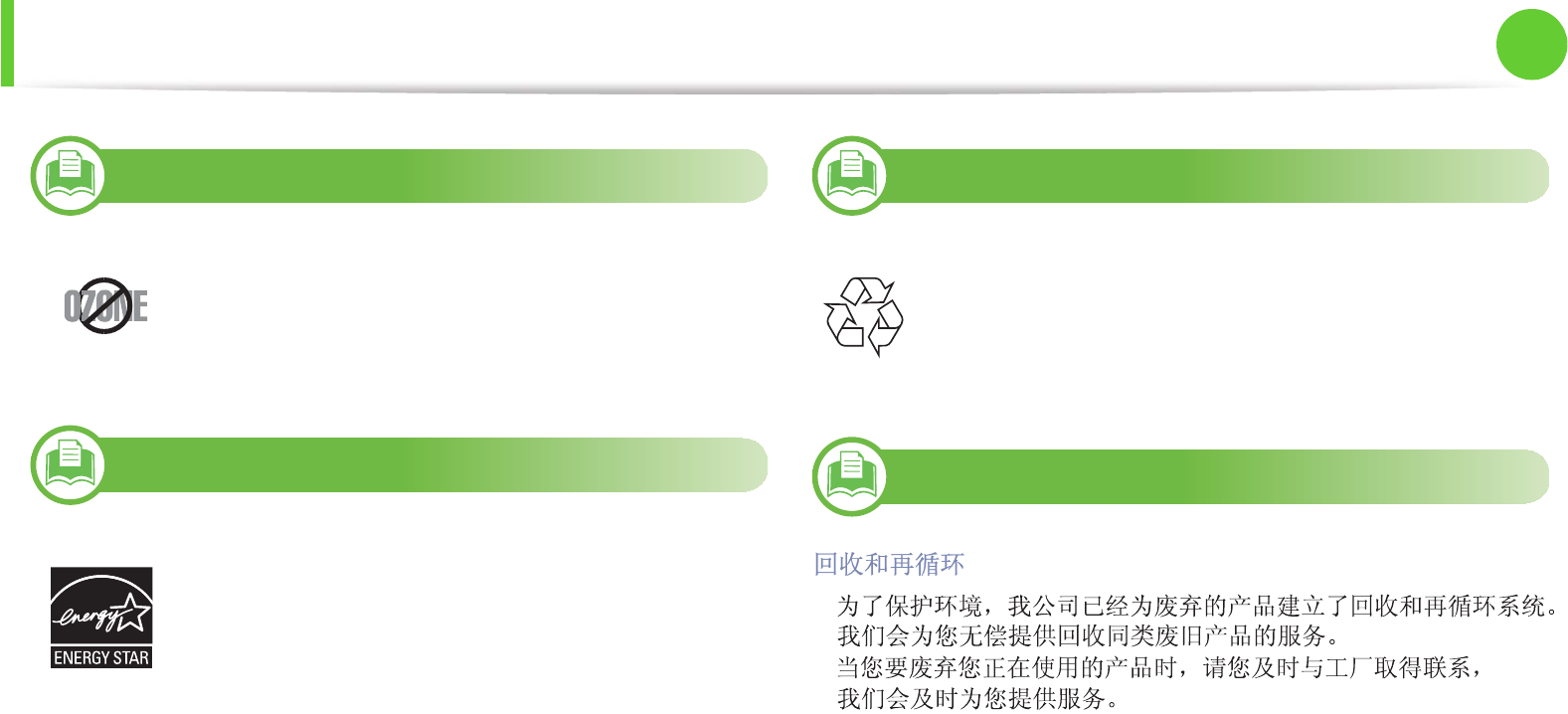
Regulatory information 92
5. Appendix
7
Ozone safety
8
Power saver
9
Recycling
10
China only
This product's ozone emission rate is under 0.1 ppm.
Because ozone is heavier than air, keep the product in
a place with good ventilation.
This printer contains advanced energy conservation
technology that reduces power consumption when it is
not in active use.
When the printer does not receive data for an extended
period of time, power consumption is automatically
lowered.
ENERGY STAR and the ENERGY STAR mark are
registered U.S. marks.
For more information on the ENERGY STAR program
see http://www.energystar.gov
Recycle or dispose of the packaging material for this
product in an environmentally responsible manner.
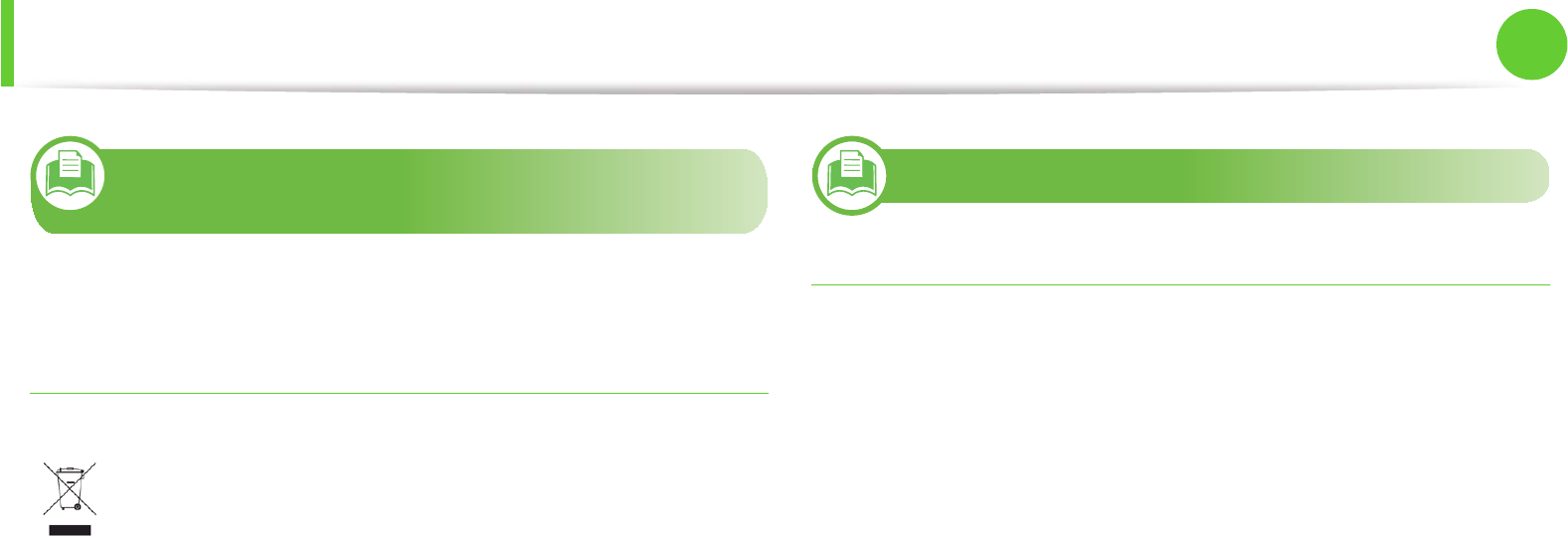
Regulatory information 93
5. Appendix
11
Correct disposal of this product (Waste
electrical & electronic equipment)
(Applicable in the european union and other
european countries with separate collection
systems)
12
Radio frequency emissions
FCC information to the user
This device complies with Part 15 of the FCC Rules. Operation is
subject to the following two conditions:
• This device may not cause harmful interference, and
• This device must accept any interference received, including
interference that may cause undesired operation.
This equipment has been tested and found to comply with the limits
for a Class B digital device, pursuant to Part 15 of the FCC Rules.
These limits are designed to provide reasonable protection against
harmful interference in a residential installation. This equipment
generates, uses and can radiate radio frequency energy and, if not
installed and used in accordance with the instructions, may cause
harmful interference to radio communications. However, there is no
guarantee that interference will not occur in a particular installation.
If this equipment does cause harmful interference to radio or
television reception, which can be determined by turning the
equipment off and on, the user is encouraged to try to correct the
interference by one or more of the following measures:
• Reorient or relocate the receiving antenna.
• Increase the separation between the equipment and receiver.
This marking on the product, accessories or literature
indicates that the product and its electronic accessories (e.g.
charger, headset, USB cable) should not be disposed of with
other household waste at the end of their working life. To
prevent possible harm to the environment or human health
from uncontrolled waste disposal, please separate these
items from other types of waste and recycle them responsibly
to promote the sustainable reuse of material resources.
Household users should contact either the retailer where they
purchased this product, or their local government office, for
details of where and how they can take these items for
environmentally safe recycling.
Business users should contact their supplier and check the
terms and conditions of the purchase contract. This product
and its electronic accessories should not be mixed with other
commercial wastes for disposal.

Regulatory information 94
5. Appendix
• Connect the equipment into an outlet on a circuit different from
that to which the receiver is connected.
• Consult the dealer or experienced radio TV technician for help.
Change or modifications not expressly approved by the
manufacturer responsible for compliance could void the
user's authority to operate the equipment.
Canadian radio interference regulations
This digital apparatus does not exceed the Class B limits for radio
noise emissions from digital apparatus as set out in the interference-
causing equipment standard entitled “Digital Apparatus”, ICES-003
of the Industry and Science Canada.
Cet appareil numérique respecte les limites de bruits
radioélectriques applicables aux appareils numériques de Classe B
prescrites dans la norme sur le matériel brouilleur: “Appareils
Numériques”, ICES-003 édictée par l’Industrie et Sciences Canada.
13
United states of america
Federal communications commission (FCC)
ŹIntentional emitter per FCC Part 15
Low power, Radio LAN type devices (radio frequency (RF) wireless
communication devices), operating in the 2.4 GHz/5 GHz Band, may
be present (embedded) in your printer system. This section is only
applicable if these devices are present. Refer to the system label to
verify the presence of wireless devices.
Wireless devices that may be in your system are only qualified for use
in the United States of America if an FCC ID number is on the system
label.
The FCC has set a general guideline of 20 cm (8 inches) separation
between the device and the body, for use of a wireless device near
the body (this does not include extremities). This device should be
used more than 20 cm (8 inches) from the body when wireless
devices are on. The power output of the wireless device (or devices),
which may be embedded in your printer, is well below the RF
exposure limits as set by the FCC.
This transmitter must not be collocated or operation in conjunction
with any other antenna or transmitter.
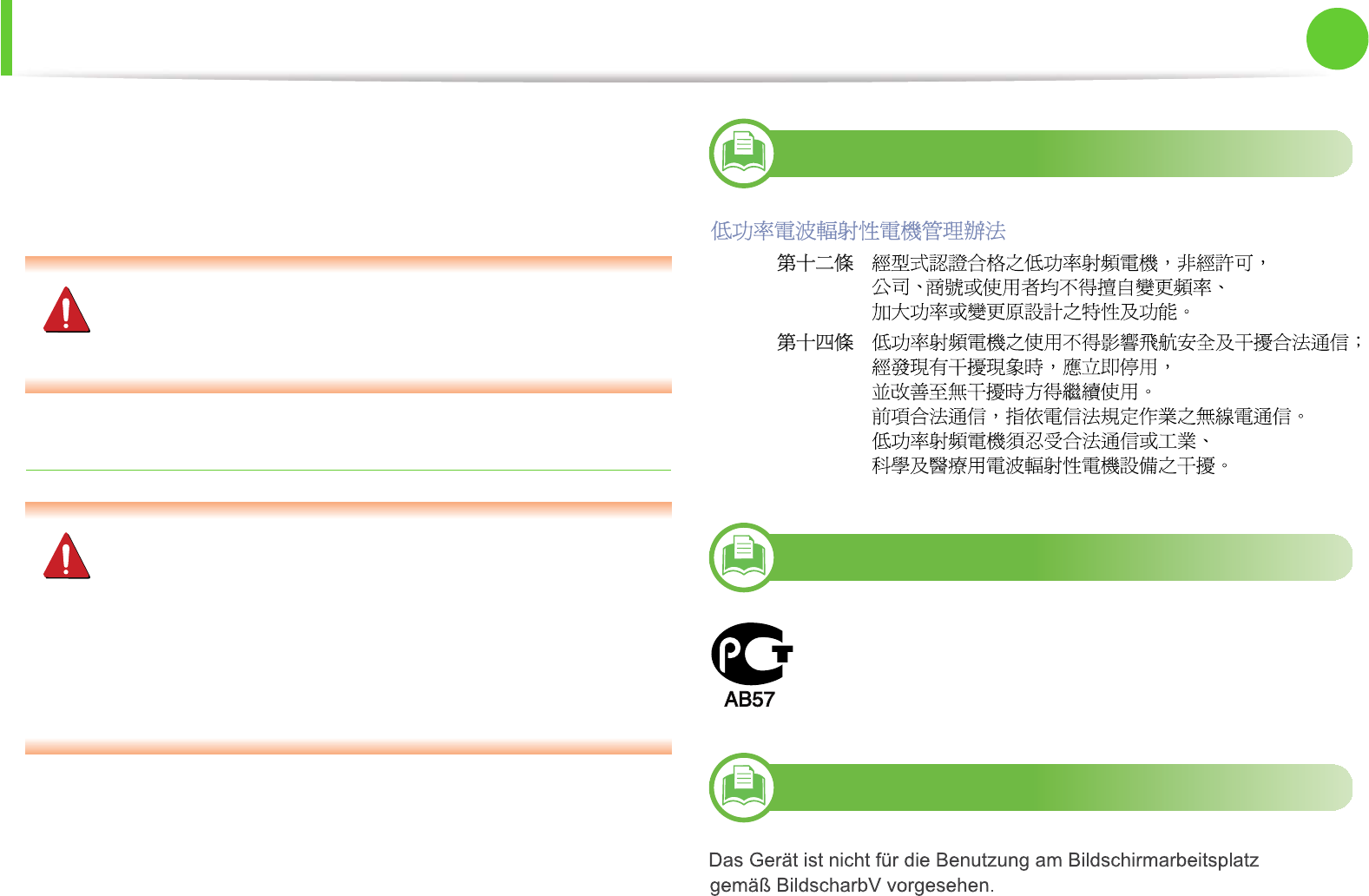
Regulatory information 95
5. Appendix
Operation of this device is subject to the following two conditions:
(1) This device may not cause harmful interference, and (2) this
device must accept any interference received, including interference
that may cause undesired operation of the device.
Wireless devices are not user serviceable. Do not modify
them in any way. Modification to a wireless device will void
the authorization to use it. Contact manufacturer for service.
FCC statement for wireless LAN use:
While installing and operating this transmitter and antenna
combination the radio frequency exposure limit of 1m W/
cm2 may be exceeded at distances close to the antenna
installed. Therefore, the user must maintain a minimum
distance of 20cm from the antenna at all times. This device
cannot be colocated with another transmitter and
transmitting antenna.
14
Taiwan only
15
Russia only
16
Germany only